Raman and Photoluminescence Mapping of Gem Materials
Abstract
1. Introduction
2. Materials and Methods
3. Distinction between Raman Shift and Photoluminescence
4. PL and Raman Mapping of Natural Diamonds with Color Zoning
4.1. Natural Pink Diamond
4.2. Natural Diamonds from Marange with Hydrogen Clouds
5. Naturally Irradiated Diamond
5.1. PL Mapping to Determine Penetration Depth of Radiation
5.2. PL Mapping Provides Clues to Unusual Origin Story
6. Inclusion Analysis within Natural Diamonds
7. PL Mapping of Laboratory-Grown Diamonds
7.1. HPHT-Grown Diamonds
7.2. CVD-Grown Diamonds
8. Blue Sapphire: Geographic Origin Determination
9. Raman Mapping of Tourmaline for Species Classification
10. Raman Mapping for Separation of Jadeite and Omphacite
10.1. Chemical Distinction between Jadeite and Omphacite
10.2. Identification Using Raman Analysis
11. Raman Mapping of Pearls
12. Future Possibilities and Conclusions
Author Contributions
Funding
Acknowledgments
Conflicts of Interest
References
- Breeding, C.M.; Shen, A.H.; Eaton-Magana, S.; Rossman, G.R.; Shigley, J.E.; Gilbertson, A. Developments in gemstone analy-sis techniques and instrumentation during the 2000s. Gems Gemol. 2010, 46, 241–257. [Google Scholar] [CrossRef]
- Lim, H.J.; Park, S.Y.; Cheong, H.S.; Choi, H.M.; Kim, Y.C. Discrimination between natural and HPHT-treated type IIa diamonds using photoluminescence spectroscopy. Diam. Relat. Mater. 2010, 19, 1254–1258. [Google Scholar] [CrossRef]
- Wotherspoon, A.; Steeds, J.W.; Catmull, B.; Butler, J. Photoluminescence and positron annihilation measurements of nitrogen doped CVD diamond. Diam. Relat. Mater. 2003, 12, 652–657. [Google Scholar] [CrossRef]
- Groat, L.A.; Giuliani, G.; Stone-Sundberg, J.; Sun, Z.; Renfro, N.D.; Palke, A.C. A review of analytical methods used in geographic origin determination of gemstones. Gems Gemol. 2019, 55, 512–535. [Google Scholar] [CrossRef]
- Bersani, D.; Lottici, P.P. Applications of Raman spectroscopy to gemology. Anal. Bioanal. Chem. 2010, 397, 2631–2646. [Google Scholar] [CrossRef]
- Kiefert, L.; Karampelas, S. Use of the Raman spectrometer in gemmological laboratories: Review. Spectrochim. Acta A 2011, 80, 119–124. [Google Scholar] [CrossRef]
- Jaszczak, J.A. Raman spectroscopy in the identification and study of minerals. Rocks Miner. 2013, 88, 184–189. [Google Scholar] [CrossRef]
- Loudin, L.C. Photoluminescence mapping of optical defects in HPHT synthetic diamond. Gems Gemol. 2017, 53, 180–188. [Google Scholar] [CrossRef]
- Fiquet, G.; Richet, P.; Montagnac, G. High-temperature thermal expansion of lime, periclase, corundum and spinel. Phys. Chem. Miner. 1999, 27, 103–111. [Google Scholar] [CrossRef]
- Read, P.G. Gemmology, 3rd ed.; Elsevier Butterworth-Heinemann: Oxford, UK, 2008. [Google Scholar]
- Collins, A.T. Colour centres in diamond. J. Gemmol. 1982, 18, 37–75. [Google Scholar] [CrossRef]
- Eaton-Magana, S.; Breeding, C.M. An introduction to photoluminescence spectroscopy for diamond and its application to gemology. Gems Gemol. 2016, 52, 2–17. [Google Scholar] [CrossRef]
- Eaton-Magana, S.; McElhenny, G.; Breeding, C.M.; Ardon, T. Comparison of gemological and spectroscopic features in type IIa and Ia natural pink diamonds. Diam. Relat. Mater. 2020, 105, 107784. [Google Scholar] [CrossRef]
- Eaton-Magana, S.; Ardon, T. Spatial distribution of defects in natural type IIb diamond after irradiation and annealing. Diam. Relat. Mater. 2020, 109, 108034. [Google Scholar] [CrossRef]
- Renfro, N.D.; Palke, A.C.; Berg, R.B. Gemological characterization of sapphires from Yogo Gulch, Montana. Gems Gemol. 2018, 54, 184–201. [Google Scholar] [CrossRef]
- Zaitsev, A.M. Optical Properties of Diamond; Springer: New York, NY, USA, 2003. [Google Scholar]
- Hainschwang, T.; Notari, F.; Pamies, G. A defect study and classification of brown diamonds with deformation-related color. Minerals 2020, 10, 903. [Google Scholar] [CrossRef]
- Crameri, F.; Shephard, G.E.; Heron, P.J. The misuse of colour in science communication. Nat. Commun. 2020, 11, 1–10. [Google Scholar] [CrossRef] [PubMed]
- Raman, C.V.; Krishnan, K.S. A new type of secondary radiation. Nature 1928, 121, 501–502. [Google Scholar] [CrossRef]
- Gaillou, E.; Post, J.E.; Bassim, N.D.; Zaitsev, A.M.; Rose, T.; Fries, M.D.; Stroud, R.M.; Steele, A.; Butler, J.E. Spectroscopic and microscopic characterizations of color lamellae in natural pink diamonds. Diam. Relat. Mater. 2010, 19, 1207–1220. [Google Scholar] [CrossRef]
- Howell, D.; Fisher, D.; Piazolo, S.; Griffin, W.L.; Sibley, S.J. Pink color in Type I diamonds: Is deformation twinning the cause? Am. Mineral. 2015, 100, 1518–1527. [Google Scholar] [CrossRef]
- Titkov, S.V.; Mineeva, R.M.; Zudin, N.G.; Sergeev, A.M.; Speransky, A.V.; Shigley, J.E.; Breeding, C.M. Spectroscopic and gemological study of purple diamonds from Siberia. In Proceedings of the 30th International Gemmological Conference, Moscow, Russia, 15–19 July 2007; pp. 123–124. [Google Scholar]
- Eaton-Magana, S.; Ardon, T.; Zaitsev, A.M. Inclusion and point defect charactereistics of Marange graphite-bearing diamonds and high temperature annealing. Diam. Relat. Mater. 2017, 71, 20–29. [Google Scholar] [CrossRef]
- Smit, K.V.; Shirey, S.B.; Stern, R.A.; Steele, A.; Wang, W. Diamond growth from C-H-N-O recycled fluids in the lithosphere: Evidence from CH4 micro-inclusions and delta13C-delta15N-N content in Marange mixed-habit diamonds. Lithos 2016, 265, 68–81. [Google Scholar] [CrossRef]
- Rondeau, B.; Fritsch, E.; Guiraud, M.; Chalain, J.P.; Notari, F. Three historical ‘asteriated’ hydrogen-rich diamonds: Growth history and sector-dependent impurity incorporation. Diam. Relat. Mater. 2004, 13, 1658–1673. [Google Scholar] [CrossRef]
- Lang, A.R.; Bulanova, G.P.; Fisher, D.; Furkert, S.; Sarua, A. Defects in a mixed-habit Yakutian diamond: Studies by optical and cathodoluminescence microscopy, infrared absorption, Raman scattering and photoluminescence spectroscopy. J. Cryst. Growth 2007, 309, 170–180. [Google Scholar] [CrossRef]
- Breeding, C.M.; Eaton-Magana, S.; Shigley, J.E. Natural-color green diamonds: A beautiful conundrum. Gems Gemol. 2018, 54, 2–27. [Google Scholar] [CrossRef]
- Kane, R.E.; McClure, S.F.; Menzhausen, J. The legendary Dresden Green diamond. Gems Gemol. 1990, 26, 248–266. [Google Scholar] [CrossRef]
- Bosshart, G. The Dresden green. J. Gemmol. 1989, 21, 351–362. [Google Scholar] [CrossRef]
- Zaitsev, A.M.; Moe, K.S.; Wang, W. Optical centers and their depth distribution in electron irradiated CVD diamond. Diam. Relat. Mater. 2017, 71, 38–52. [Google Scholar] [CrossRef]
- Nasdala, L.; Grambole, D.; Wildner, M.; Gigler, A.M.; Hainschwang, T.; Zaitsev, A.M.; Harris, J.W.; Milledge, J.; Schulze, D.; Hofmeister, W.; et al. Radio-colouration of diamond: A spectroscopic study. Contrib. Miner. Pet. 2012, 165, 843–861. [Google Scholar] [CrossRef]
- Eaton-Magana, S.; Moe, K.S. Temperature effects on radiation stains in natural diamonds. Diam. Relat. Mater. 2016, 64, 130–142. [Google Scholar] [CrossRef]
- Ardon, T.; Eaton-Magana, S. Multiple radiation stains suggest interesting geological residency. Gems Gemol. 2020, 56, 283–285. [Google Scholar]
- Eaton-Magana, S.; McElhenny, G. Diamond with cavities showing radiation evidence. Gems Gemol. 2020, 56, 126–127. [Google Scholar]
- Wang, W.; Yazawa, E.; Persaud, S.; Myagkaya, E.; D’Haenens-Johansson, U.F.S.; Moses, T.M. Formation of the "Matryoshka" Diamond from Siberia. Gems Gemol. 2020, 56, 127–128. [Google Scholar]
- Gem News International. Crowningshieldite: A new mineral. Gems Gemol. 2018, 54, 469. [Google Scholar]
- Smith, E.M.; Shirey, S.B.; Wang, W. The very deep origin of the world’s biggest diamonds. Gems Gemol. 2017, 53, 388–403. [Google Scholar] [CrossRef]
- Renfro, N.D.; Koivula, J.I.; Muyal, J.; McClure, S.F.; Schumacher, K.; Shigley, J.E. Chart: Inclusions in natural, synthetic, and treated diamond. Gems Gemol. 2018, 54, 428–429. [Google Scholar]
- McElhenny, G.; Turner, M.; Breeding, C.M. Corundum Inclusions in Gem Diamond. Gems Gemol. 2020, 56, 129–131. [Google Scholar]
- Welbourn, C.M.; Cooper, M.; Spear, P.M. De Beers natural versus synthetic diamond verification instruments. Gems Gemol. 1996, 32, 156–169. [Google Scholar] [CrossRef]
- Eaton-Magana, S.; Shigley, J.E. Observations on CVD-grown synthetic diamonds: A review. Gems Gemol. 2016, 52, 222–245. [Google Scholar] [CrossRef]
- Palke, A.C.; Saeseaw, S.; Renfro, N.D.; Sun, Z.; McClure, S.F. Geographic origin determination of blue sapphire. Gems Gemol. 2019, 55, 536–579. [Google Scholar] [CrossRef]
- Dubinsky, E.V.; Stone-Sundberg, J.; Emmet, J.L. A quantitative description of the causes of color in corundum. Gems Gemol. 2020, 56, 2–28. [Google Scholar] [CrossRef]
- Emmett, J.L.; Stone-Sundberg, J.; Guan, Y.; Sun, Z. The role of silicon in the color of gem corundum. Gems Gemol. 2017, 53, 42–47. [Google Scholar] [CrossRef]
- Zaw, K.; Sutherland, L.; Yui, T.F.; Meffre, S.; Thu, K. Vanadium-rich ruby and sapphire within Mogok Gemfield, Myanmar: Implications for gem color and genesis. Miner. Deposita 2015, 50, 25–39. [Google Scholar] [CrossRef]
- Sorokina, E.S.; Hofmeister, W.; Hager, T.; Mertz-Kraus, R.; Buhre, S.; Saul, J.M. Morphological and chemical evolution of corundum (ruby and sapphire): Crystal ontogeny reconstructed by EPMA, LA-ICP-MS, and Cr3+ Raman mapping. Am. Mineral. 2016, 101, 2716–2722. [Google Scholar] [CrossRef]
- Palke, A.C. Coexisting rubies and blue sapphires from major world deposits: A brief review of their mineralogical properties. Minerals 2020, 10, 472. [Google Scholar] [CrossRef]
- McClure, S.F.; Moses, T.M.; Shigley, J.E. What’s Next? Gems Gemol. 2019, 55, 682–684. [Google Scholar]
- Katsurada, Y.; Sun, Z. Cuprian liddicoatite tourmaline. Gems Gemol. 2017, 53, 34–41. [Google Scholar] [CrossRef]
- Katsurada, Y.; Sun, Z.; Breeding, C.M.; Dutrow, B.L. Geographic origin determination of Paraiba tourmaline. Gems Gemol. 2019, 55, 648–659. [Google Scholar] [CrossRef]
- Sun, Z.; Palke, A.C.; Breeding, C.M.; Dutrow, B.L. A new method for determining gem tourmaline species by LA-ICP-MS. Gems Gemol. 2019, 55, 2–17. [Google Scholar] [CrossRef]
- Dirlam, D.M.; Laurs, B.M.; Pezzotta, F.; Simmons, W.B. Liddicoatite tourmaline from Anjanabonoina, Madagascar. Gems Gemol. 2002, 38, 28–53. [Google Scholar] [CrossRef]
- Henry, D.J.; Dutrow, B.L. The incorporation of fluorine in tourmaline: Internal crystallographic controls or external environmental influences? Can. Miner. 2011, 49, 41–56. [Google Scholar] [CrossRef]
- Hoang, L.H.; Hien, N.T.M.; Chen, X.B.; Minh, N.V.; Yang, I.S. Raman spectroscopic study of various types of tourmaline. J. Raman Spectrosc. 2011, 42, 1442–1446. [Google Scholar] [CrossRef]
- McClure, S.F. The Jadeite/Omphacite Nomenclature Question, GIA News from Research; Gemological Institute of America: Carlsbad, CA, USA, 2012. [Google Scholar]
- Franz, L.; Sun, T.T.; Hänni, H.A.; de Capitani, C.; Thanasuthipitak, T.; Atichat, W. A comparative study of jadeite, omphacite and kosmochlor jades from Myanmar, ans suggestions for a practical nomenclature. J. Gemmol. 2014, 34, 210–229. [Google Scholar] [CrossRef]
- Coccato, A.; Karampelas, S.; Worle, M.; van Willigen, S.; Petrequin, P. Gem quality and archaeological green ‘jadeite jade’ versus ‘omphacite jade’. J. Raman Spectrosc. 2014, 45, 1260–1265. [Google Scholar] [CrossRef]
- Lafuente, B.; Downs, R.T.; Yang, H.; Stone, N. The Power of Databases: The RRUFF Project; Walter de Gruyter GmbH: Berlin, Germany, 2016. [Google Scholar]
- Wang, W.; Scarratt, K.; Hyatt, A.; Shen, A.H.-T.; Hall, M. Identification of “chocolate pearls” treated by Ballerina Pearl Co. Gems Gemol. 2006, 42, 222–235. [Google Scholar] [CrossRef]
- Karampelas, S.; Fritsch, E.; Mevellec, J.Y.; Gauthier, J.P.; Sklavounos, S.; Soldatos, T. Determination by Raman scattering of the nature of pigments in cultured freshwater pearls from the mollusk Hyriopsis cumingi. J. Raman Spectrosc. 2007, 38, 217–230. [Google Scholar] [CrossRef]
- Liping, L.; Zhonghui, C. Cultured pearls and colour-changed cultured pearls: Raman spectra. J. Gemmol. 2001, 27, 449–455. [Google Scholar] [CrossRef]
- Hänni, H.A. Explaining the flame structure of non-nacreous pearls. Aust. Gemmol. 2010, 24, 85–88. [Google Scholar]
- Scarratt, K.; Hanni, H.A. Pearls from the lion’s paw scallop. J. Gemmol. 2004, 29, 193–203. [Google Scholar] [CrossRef]
- Sturman, N.; Homkrajae, A.; Manustrong, A.; Somsa-ard, N. Observations on pearls reportedly from the Pinnidae family (Pen pearls). Gems Gemol. 2014, 50, 202–215. [Google Scholar] [CrossRef]
- LeCroy, B.; Homkrajae, A. 15.53 ct pearl discovered in edible oyster from the Ostreidae family. Gems Gemol. 2020, 56, 420–422. [Google Scholar]
- Strack, E. Pearls; Rϋhle-Diebener: Stuttgart, Germany, 2006. [Google Scholar]
- Ma, H.Y.; Lee, I.S. Characterization of vaterite in low quality freshwater cultured pearls. Mater. Sci. Eng. C 2006, 26, 721–723. [Google Scholar] [CrossRef]
- Wehrmeister, U.; Jacob, D.E.; Soldati, A.L.; Hager, T.; Hofmeister, W. Vaterite in freshwater cultured pearls from China and Japan. J. Gemmol. 2007, 30, 399–412. [Google Scholar] [CrossRef]
- Qiao, L.; Feng, Q.-L.; Li, Z. Special vaterite found in freshwater lackluster pearls. Cryst. Growth Des. 2007, 7, 275–279. [Google Scholar] [CrossRef]
- Bourrat, X.; Qiao, L.; Feng, Q.L.; Angellier, M.; Dissaux, A.; Beny, J.M.; Barbin, V.; Stempfle, P.; Rousseau, M.; Lopez, E. Origin of growth defects in pearl. Mater. Charact. 2012, 72, 94–103. [Google Scholar] [CrossRef]
- Soldati, A.L.; Jacob, D.E.; Wehrmeister, U.; Hofmeister, W. Structural characterization and chemical composition of aragonite and vaterite in freshwater cultured pearls. Miner. Mag. 2008, 72, 579–592. [Google Scholar] [CrossRef]
- Sturman, N.; Otter, L.M.; Homkrajae, A.; Manustrong, A.; Nilpetploy, N.; Lawanwong, K.; Kessrapong, P.; Jochum, K.P.; Stoll, B.; Gotz, H.; et al. A pearl identification challenge. Gems Gemol. 2019, 55, 229–243. [Google Scholar] [CrossRef]
- Ma, H.; Zhang, B.; Lee, I.S.; Qin, Z.; Tong, Z.; Qiu, S. Aragonite observed in the prismatic layer of seawater-cultured pearls. Front. Mater. Sci. China 2007, 1, 326–329. [Google Scholar] [CrossRef]
- Habermann, D.; Banerjee, A.; Meijer, J.; Stephan, A. Investigation of manganese in salt- and freshwater pearls. Nucl. Instrum. Methods Phys. Res. Sect. B 2001, 181, 739–743. [Google Scholar] [CrossRef]
- Ma, H.Y.; Su, A.; Zhang, B.; Li, R.K.; Zhou, L.C.; Wang, B. Vaterite or aragonite observed in the prismatic layer of freshwater-cultured pearls from south China. Prog. Nat. Sci. 2009, 19, 817–820. [Google Scholar] [CrossRef]
- Ma, H.; Li, R.; Yang, L.; Zhang, B.; Shen, M.; Mu, S.; Wei, Q. A modified integrated model of the internal structure of Chinese cultured pearls. J. Wuhan Univ. Technol. Sci. Ed. 2011, 26, 510–513. [Google Scholar] [CrossRef]
- Karampelas, S.; Mohamed, F.; Abdulla, H.; Almahmood, F.; Flamarzi, L.; Sangsawong, S.; Alalawi, A. Chemical characteristics of freshwater and saltwater natural and cultured pearls from different bivalves. Minerals 2019, 9, 357. [Google Scholar] [CrossRef]
- Lenz, C.; Nasdala, L. A photoluminescence study of REE3+ emissions in radiation-damaged zircon. Am. Miner. 2015, 100, 1123–1133. [Google Scholar] [CrossRef]
- Lenz, C.; Belousova, E.; Lumpkin, G.R. The in-situ quantification of structural radiation damage in zircon using laser-induced confocal photoluminescence spectroscopy. Minerals 2020, 10, 83. [Google Scholar] [CrossRef]
- Lee, C.W.Y.; Cheng, J.; Cheng, K.W.; Hui, T.K.C.; Batten, T. Raman Spectroscopy and Photoluminescence Mapping of Diamonds with Multiple Fluorescence Zones. MD Tech. Rev. Lett. Available online: http://www.gems-ltd.org/resources/research/Raman%20Spectroscopy%20and%20Photoluminescence%20Mapping.docx.pdf (accessed on 3 February 2021).
- Korsakov, A.V.; Hutsebaut, D.; Theunissen, K.; Vandenabeele, P.; Stepanov, A.S. Raman mapping of coesite inclusions in garnet from the Kokchetav massif (Northern Kazakhstan). Spectrochim. Acta Part A Mol. Biomol. Spectrosc. 2007, 68, 1046–1052. [Google Scholar] [CrossRef]
- Bernard, S.; Beyssac, O.; Benzerara, K. Raman mapping using advanced line-scanning systems: Geological applications. Appl. Spectrosc. 2008, 62, 1180–1188. [Google Scholar] [CrossRef]
- Smith, D.C. Raman micro-mapping of chemical and/or physical mineral phase transformations involving jadeite, coesite, diamond or zircon in natural ultra-high pressure metamorphic environments (UHPM). 2004. Unpublished work. [Google Scholar]
- Zeug, M.; Vargas, A.I.R.; Nasdala, L. Spectroscopic study of inclusions in gem corundum from Mercaderes, Cauca, Colombia. Phys. Chem. Miner. 2016, 44, 221–233. [Google Scholar] [CrossRef]
- Babich, Y.V.; Feigelson, B.N. Spatial distribution of the nitrogen defects in synthetic diamond monocrystals: Data of IR mapping. Geochem. Int. 2009, 47, 94–98. [Google Scholar] [CrossRef]
- Shiryaev, A.A.; Johner, N.; Zedgenizov, D.A. Infra-red mapping of defects in diamonds using a focal plane array (FPA) detector. In Proceedings of the 20th General Meeting International Mineralogical Association, Budapest, Hungary, 21–27 August 2010. [Google Scholar]
- Howell, D.; O’Neill, C.J.; Grant, K.J.; Griffin, W.L.; O’Reilly, S.Y.; Pearson, N.J.; Stern, R.A.; Stachel, T. Platelet development in cuboid diamonds: Insights from micro-FTIR mapping. Contrib. Miner. Pet. 2012, 164, 1011–1025. [Google Scholar] [CrossRef]
- Howell, D.; Collins, A.T.; Loudin, L.C.; Diggle, P.L.; D’Haenens-Johansson, U.F.S.; Smit, K.V.; Katrusha, A.N.; Butler, J.E.; Nestola, F. Automated FTIR mapping of boron distribution in diamond. Diam. Relat. Mater. 2019, 96, 207–215. [Google Scholar] [CrossRef]
- Spetsius, Z.V.; Bogush, I.N.; Kovalchuk, O.E. FTIR mapping of diamond plates of eclogitic and peridotitic xenoliths from the Nyurbinskaya pipe, Yakutia: Genetic implications. Russ. Geol. Geophys. 2015, 56, 344–353. [Google Scholar] [CrossRef]
- Edwards, P.R.; Martin, R.W.; Lee, M.R. Simultaneous cathodoluminescence hyperspectral imaging and X-ray microanalysis. Goldschmidt Conf. Abstr. 2005, A591. [Google Scholar]
- Lee, R.L.; Martin, R.W.; Edwards, P.R.; Parsons, I. Hyperspectral cathodoluminescence mapping of calcite and feldspar. Goldschmidt Conf. Abstr. 2005, A593. [Google Scholar]
- MacRae, C.M.; Wilson, N.C.; Torpy, A.; Davidson, C.J. Hyperspectral cathodoluminescence imaging and analysis extending from the ultraviolet to near-infrared. Microsc. Microanal. 2012, 18, 1239–1245. [Google Scholar] [CrossRef]
- MacRae, C.M.; Wilson, N.C.; Torpy, A. Hyperspectral cathodoluminescence. Miner. Pet. 2013, 107, 429–440. [Google Scholar] [CrossRef]
- Edwards, P.R.; Martin, R.W.; Lee, M.R. Combined cathodoluminescence hyperspectral imaging and wavelength dispersive X-ray analysis of minerals. Am. Mineral. 2007, 92, 235–242. [Google Scholar] [CrossRef]
- Lee, M.R.; Parsons, I.; Edwards, P.R.; Martin, R.W. Identification of cathodoluminescence activators in zoned alkali feldspars by hyperspectral imaging and electron-probe microanalysis. Am. Mineral. 2007, 92, 243–253. [Google Scholar] [CrossRef]
- Piñon, V.; Mateo, M.P.; Nicolas, G. Laser-induced breakdown spectroscopy for chemical mapping of materials. Appl. Spectrosc. Rev. 2013, 48, 357–383. [Google Scholar] [CrossRef]
- Liedl, A.; Polese, C.; Hampai, D.; Della-Ventura, G.; Dabagov, S.B.; Marcelli, A.; Bellatreccia, F.; Cavallo, A. X-ray micro-computed tomography and micro X-ray fluorescence mapping of synthetic emerald by using a laboratory polycapillary optics X-ray tube layout. X-ray Spectrom. 2014, 44, 201–203. [Google Scholar] [CrossRef]
- Watt, G.A.; Newton, M.E.; Baker, J.M. EPR and optical imaging of the growth-sector dependence of radiation-damage defect population in synthetic diamond. Diam. Relat. Mater. 2001, 10, 1681–1683. [Google Scholar] [CrossRef]
- Liaugaudas, G.; Collins, A.T.; Suhling, K.; Davies, G.; Heintzmann, R. Luminescence-lifetime mapping in diamond. J. Phys. Condens. Matter 2009, 21, 364210. [Google Scholar] [CrossRef] [PubMed]
- Jones, D.C.; Kumar, S.; Lanigan, P.M.; McGuinness, C.D.; Dale, M.W.; Twitchen, D.J.; Fisher, D.; Martineau, P.M.; Neil, M.A.A.; Dunsby, C.; et al. Multidimensional lumiescence microscope for imaging defect colour centres in diamond. Methods Appl. Fluoresc. 2019, 8, 014004. [Google Scholar] [CrossRef] [PubMed]
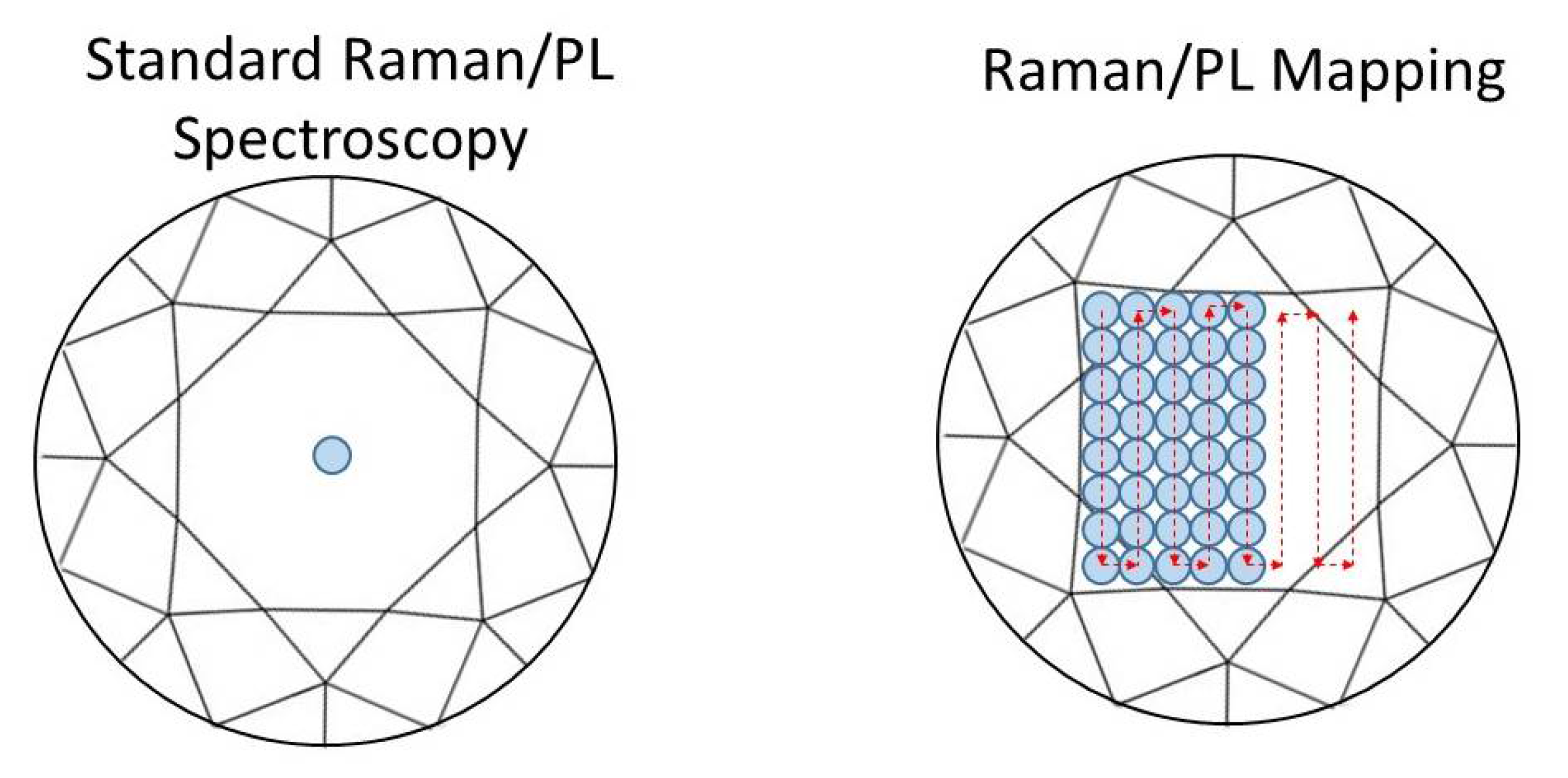
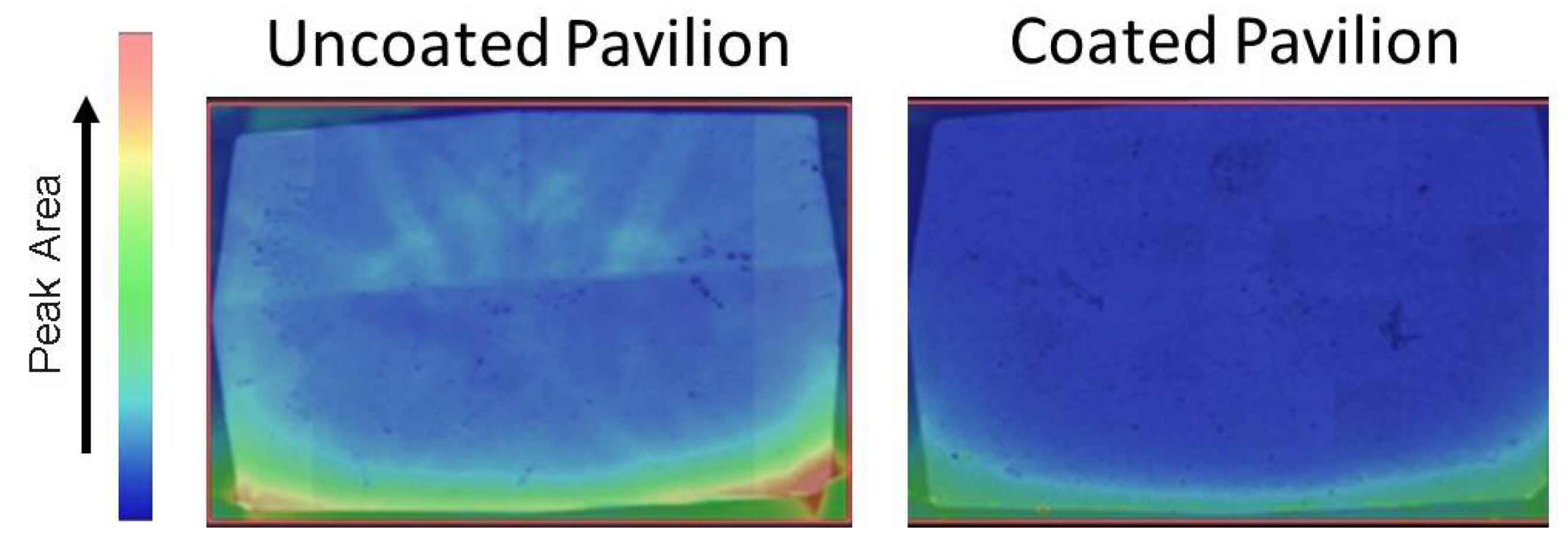
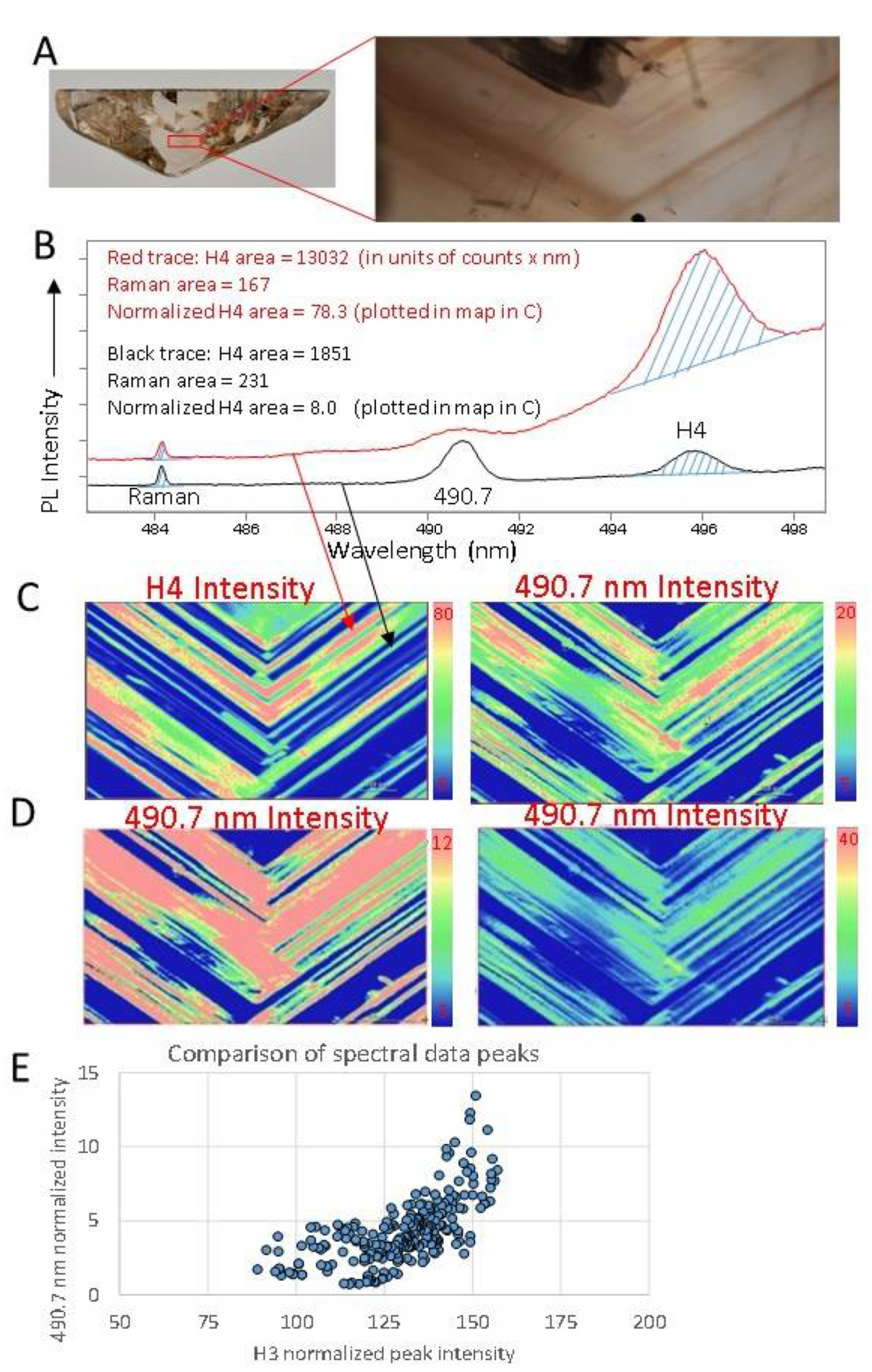
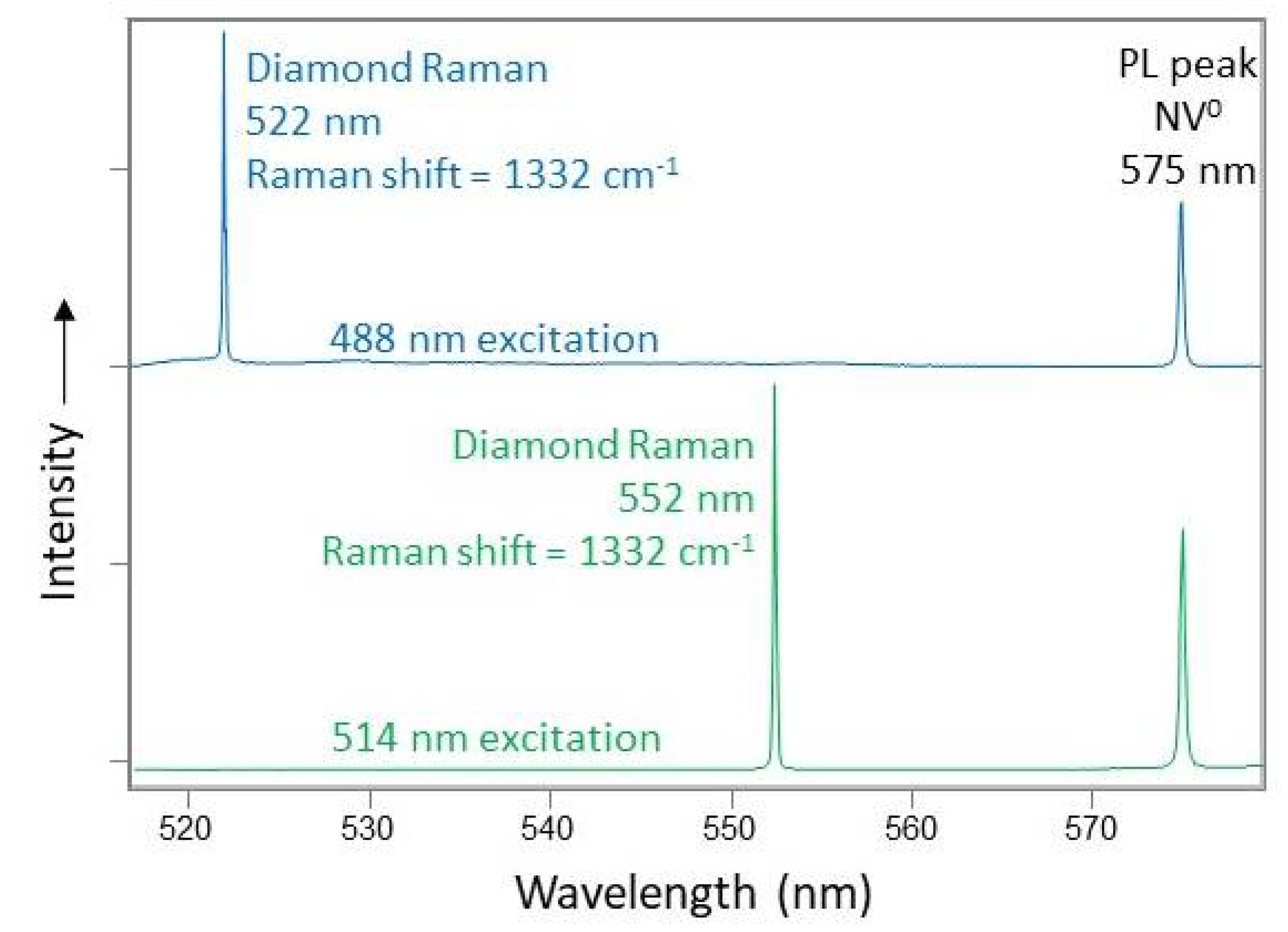

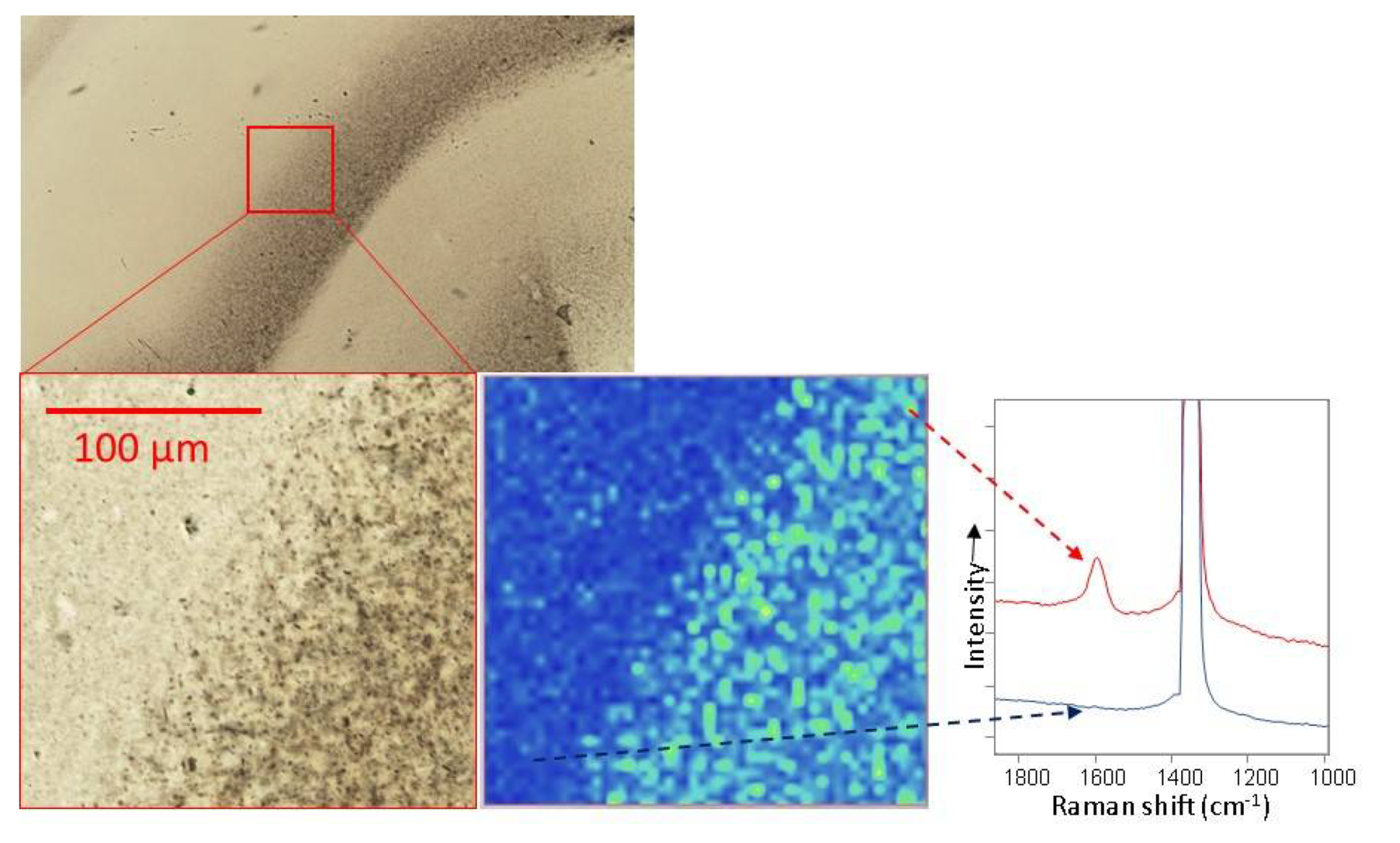
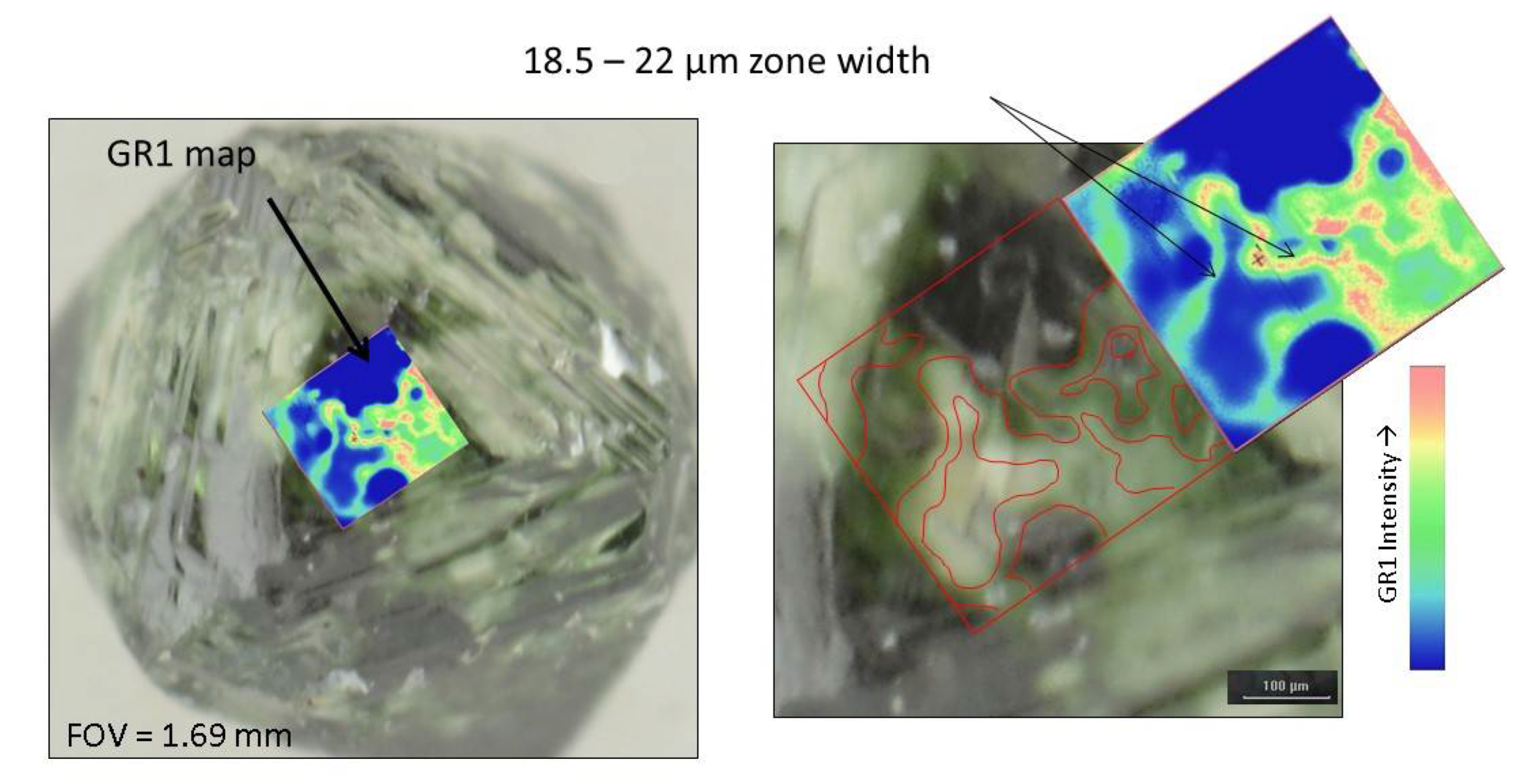
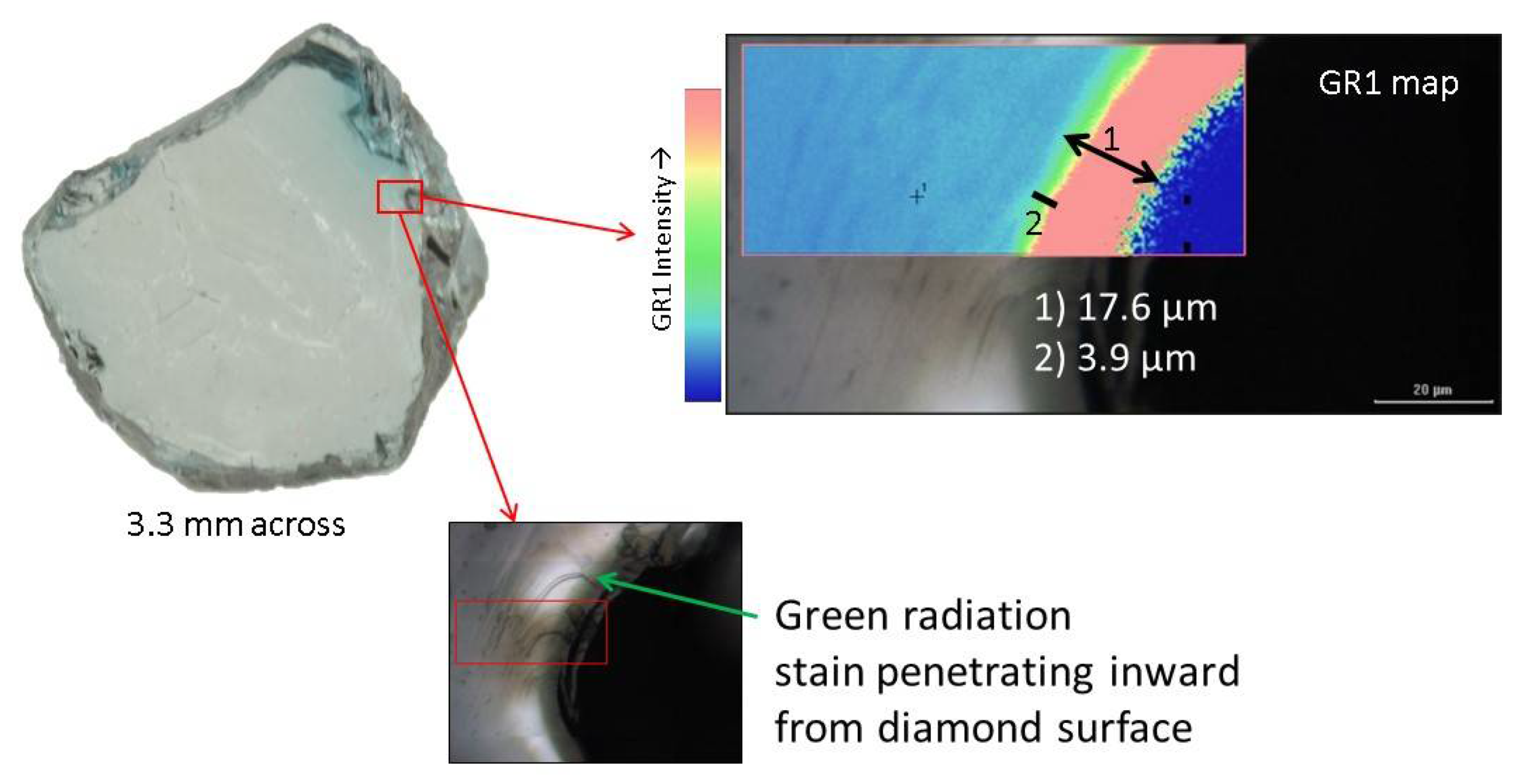
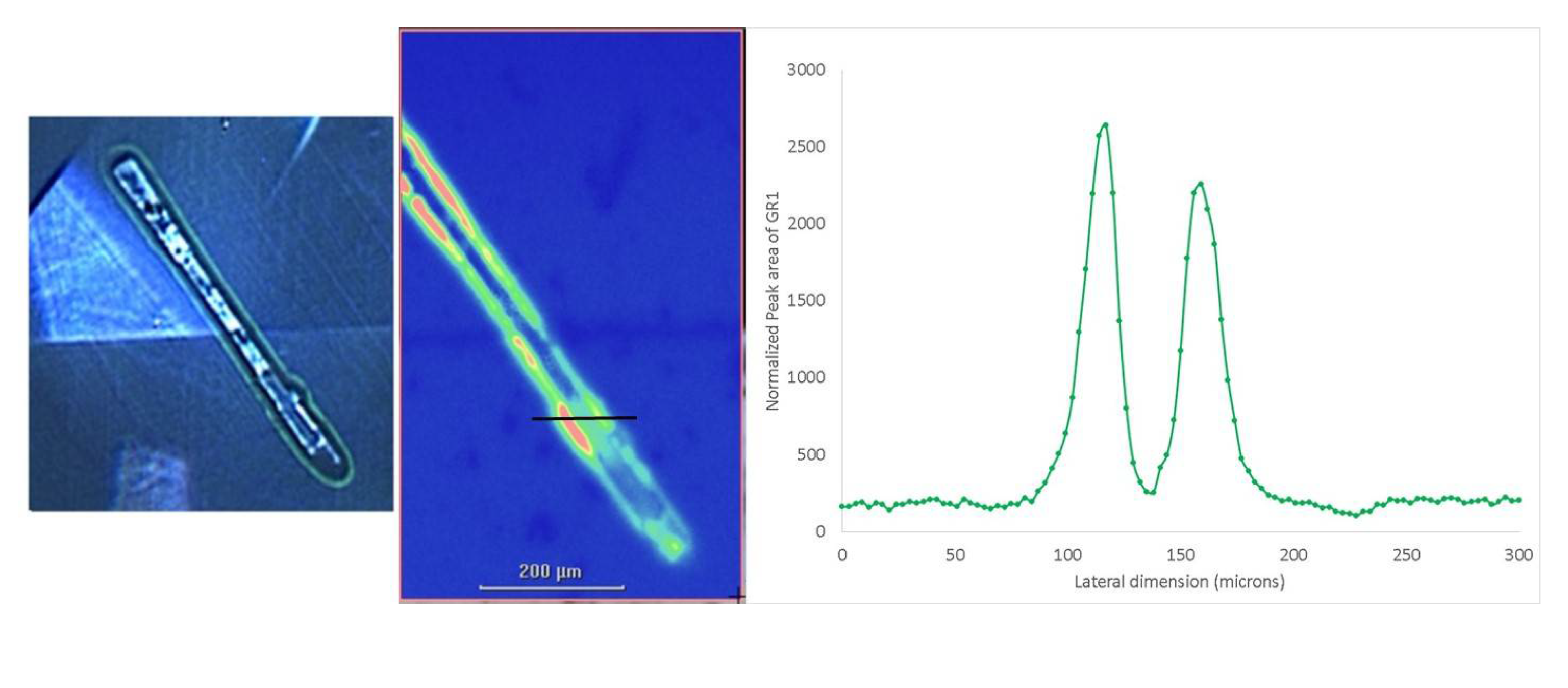
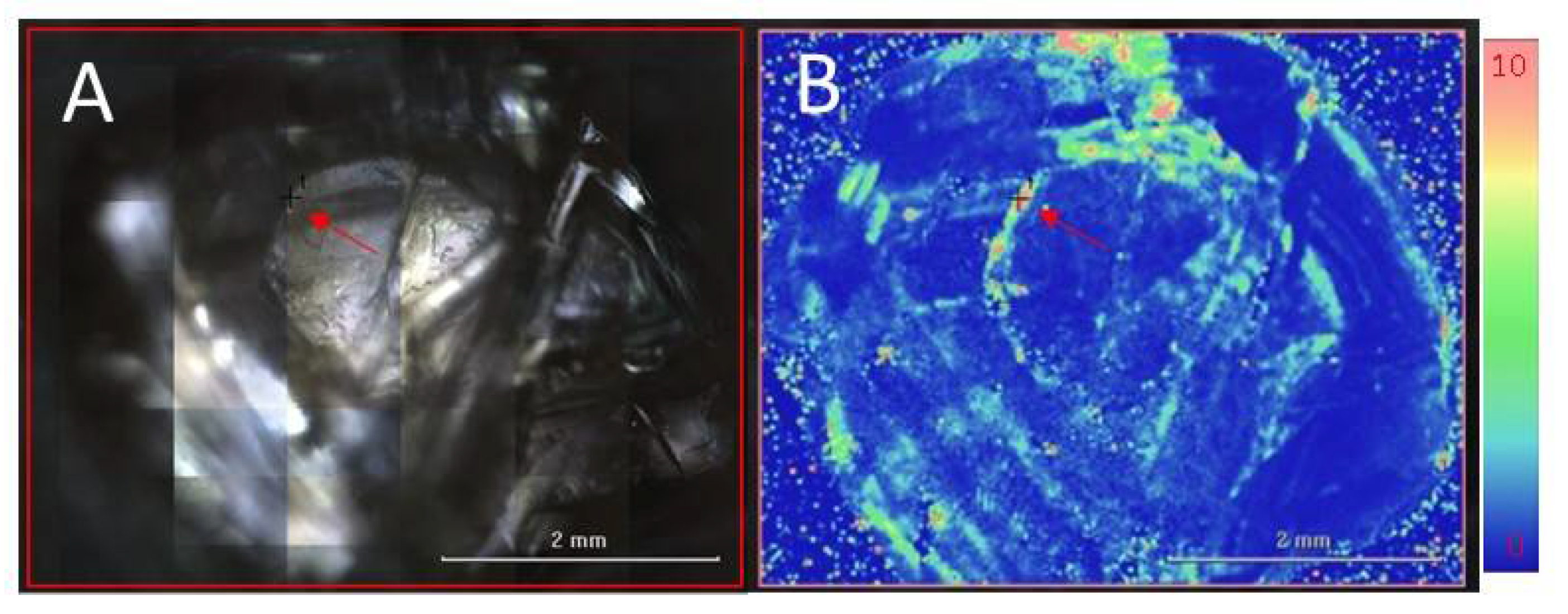
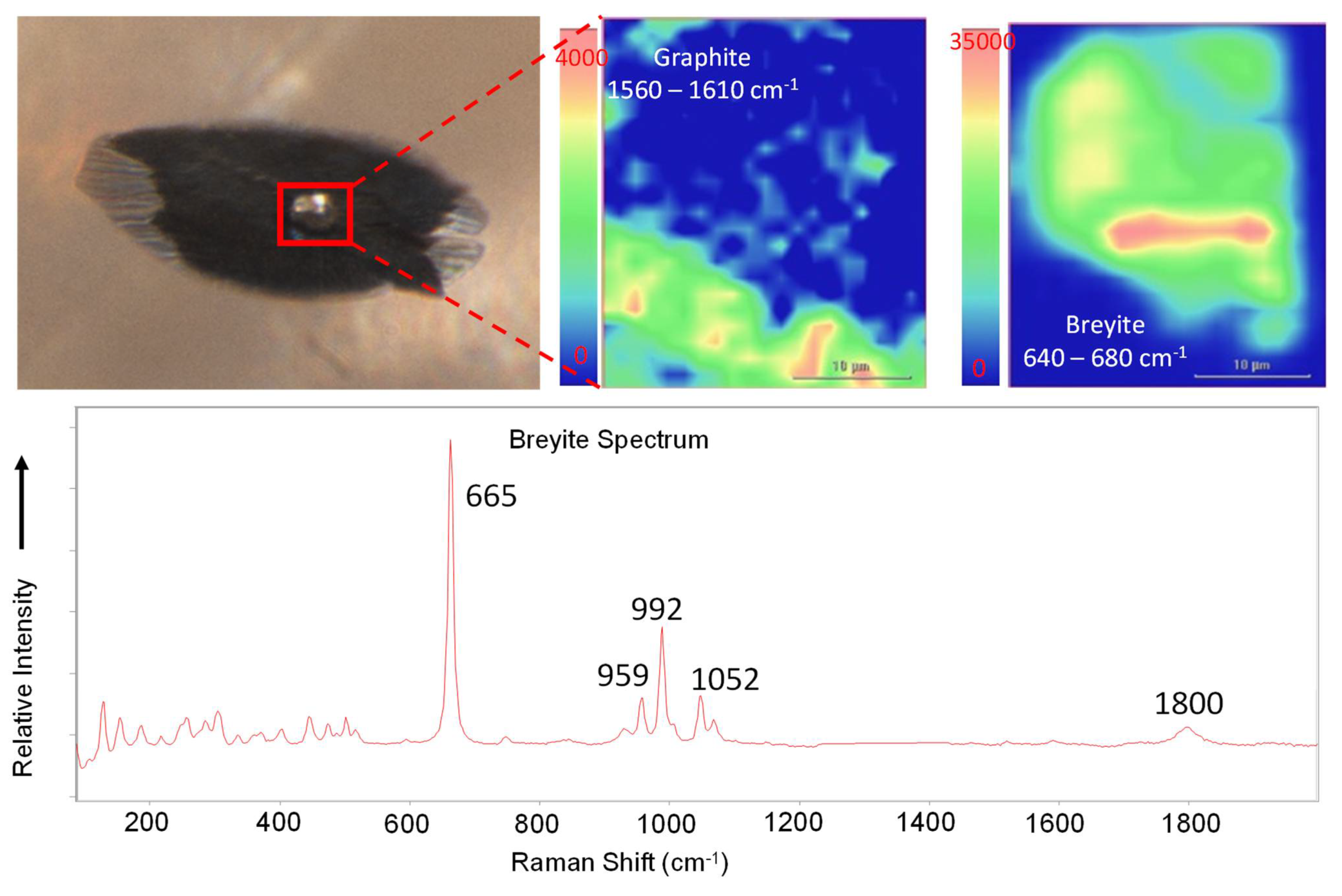
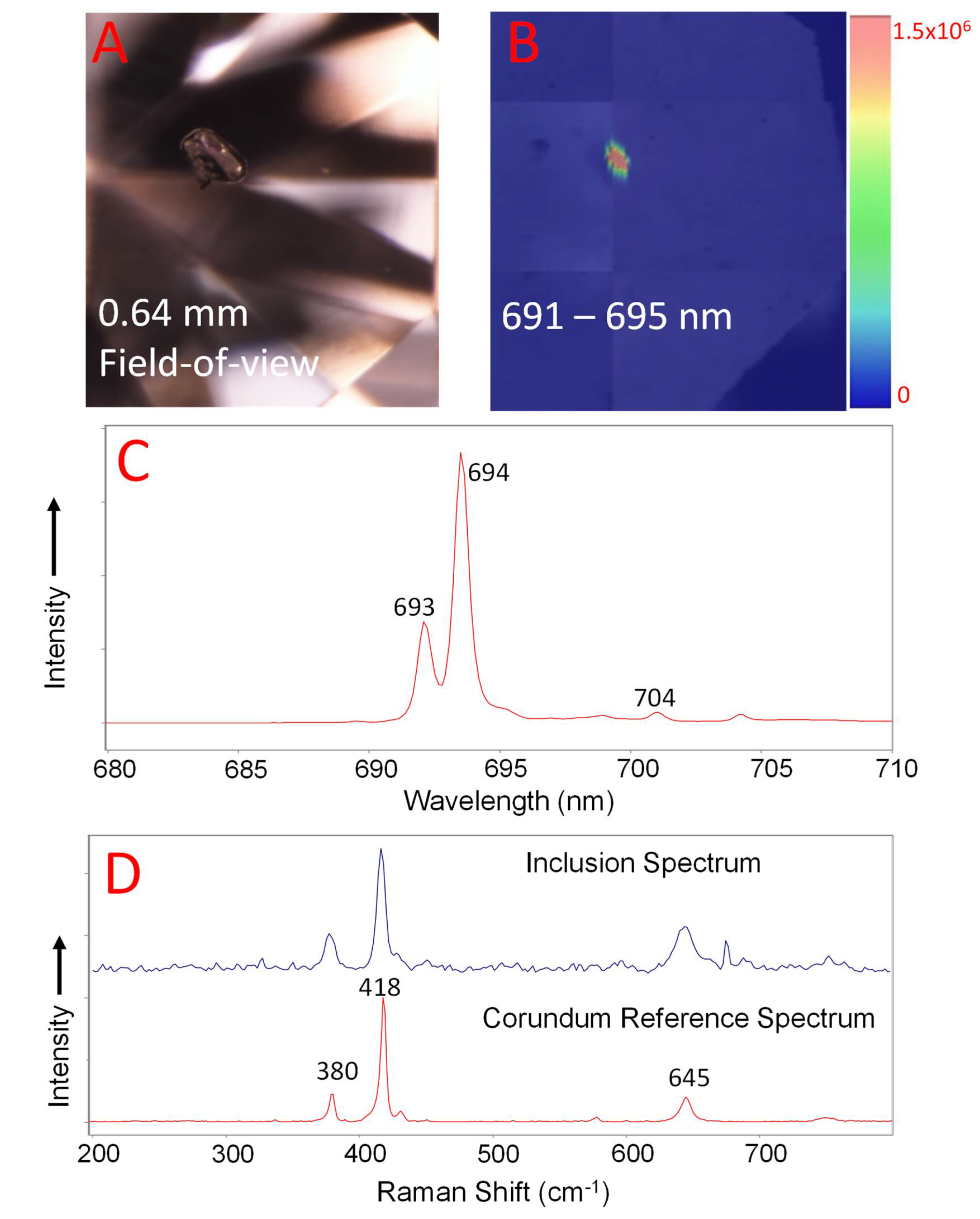

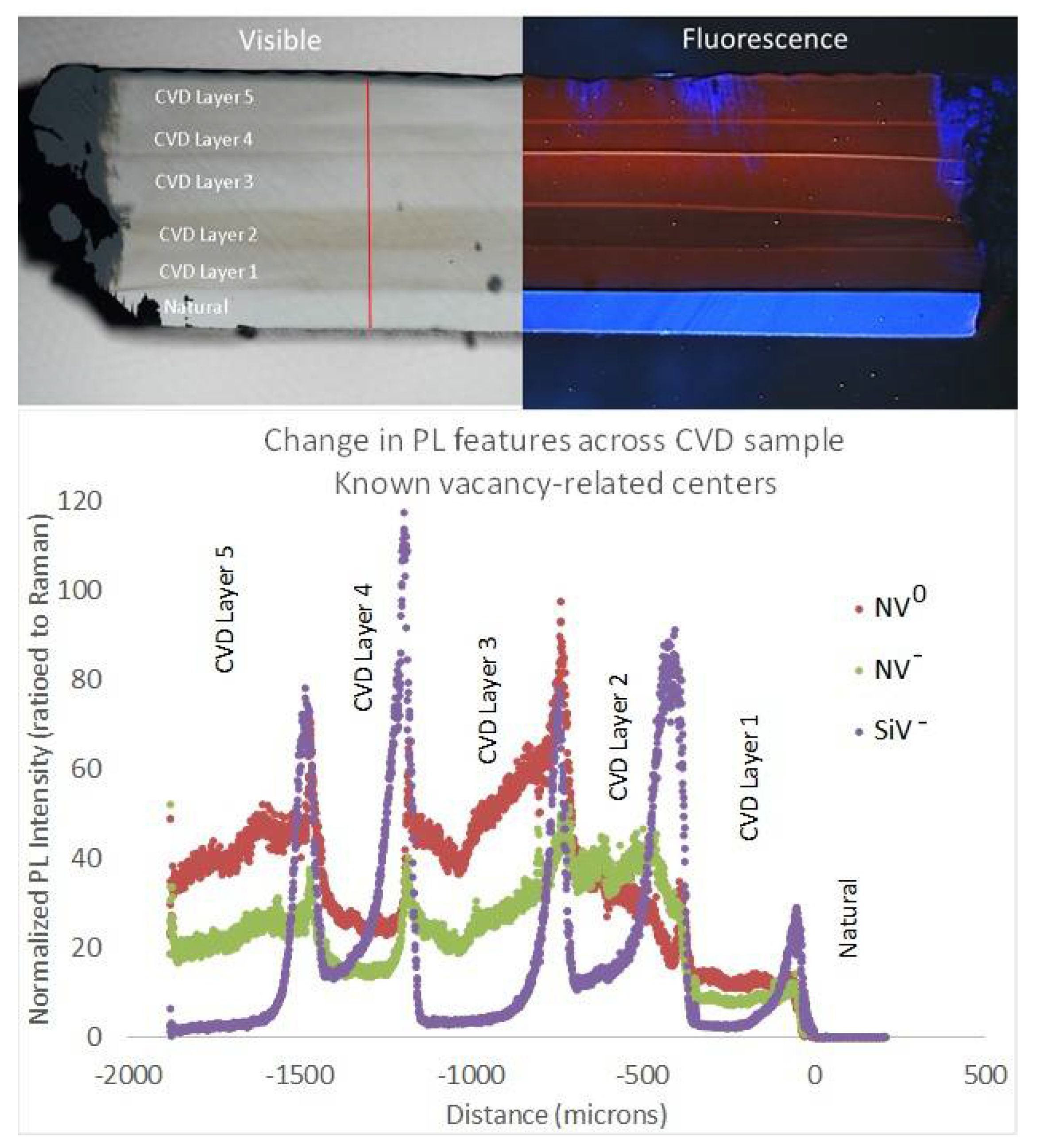
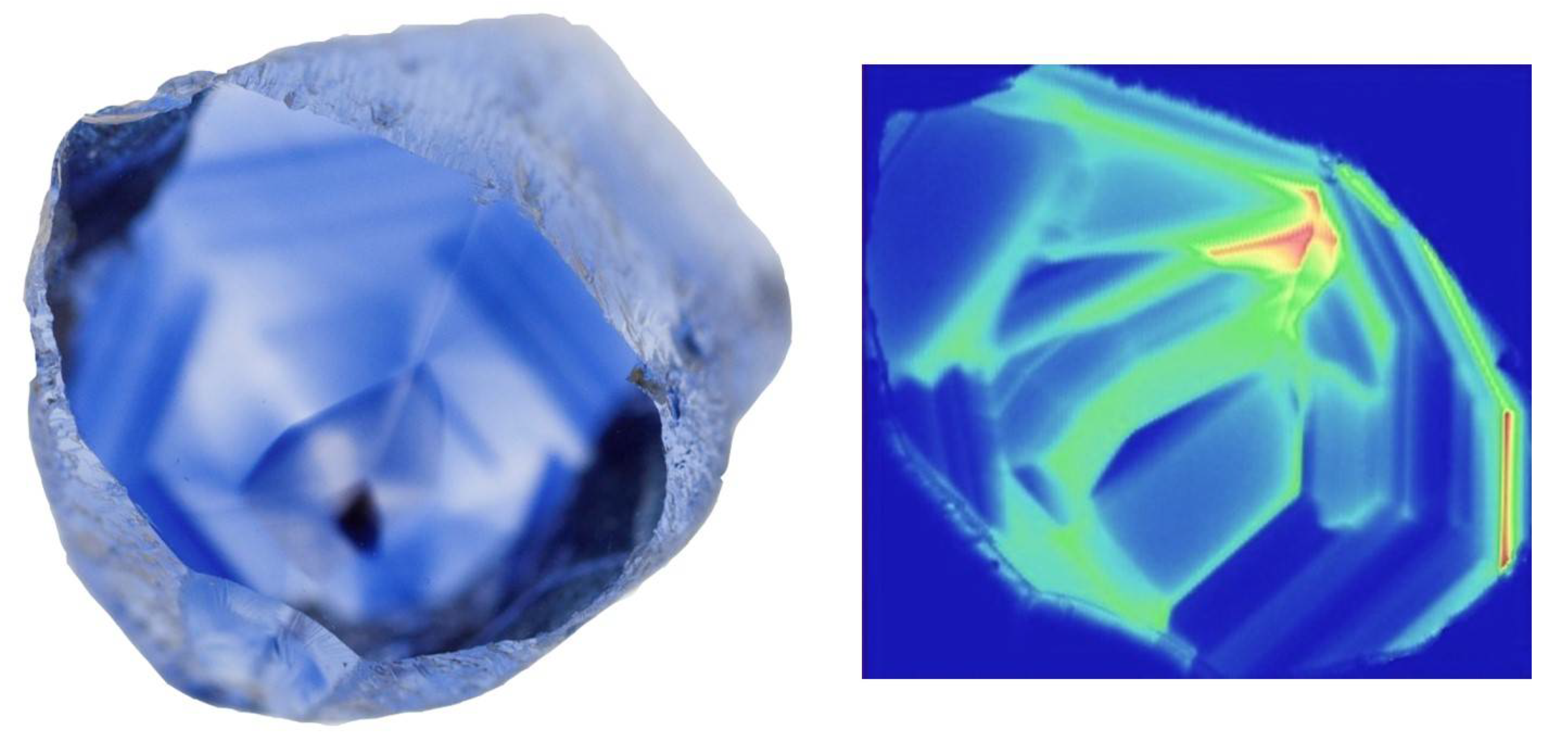
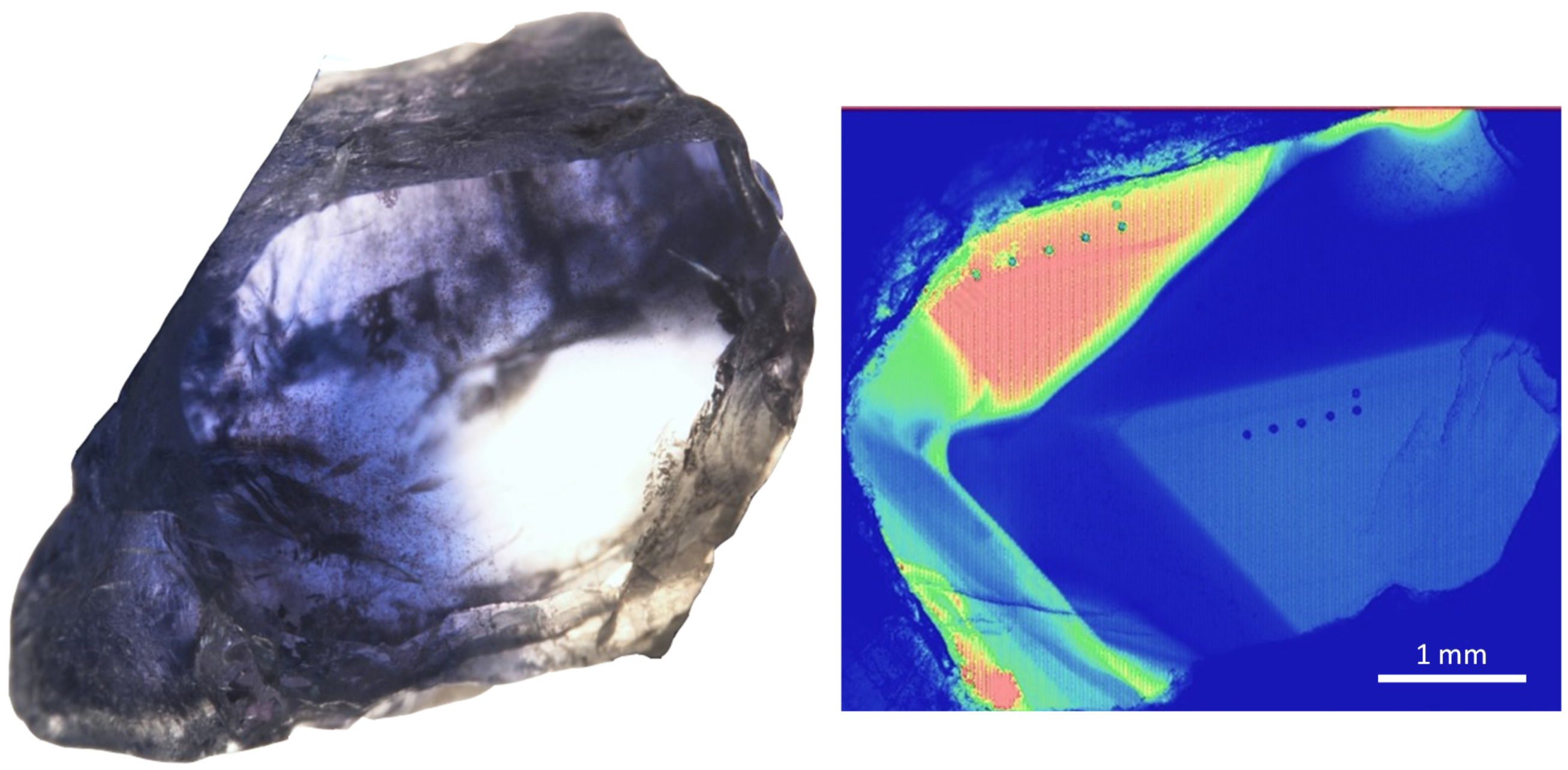
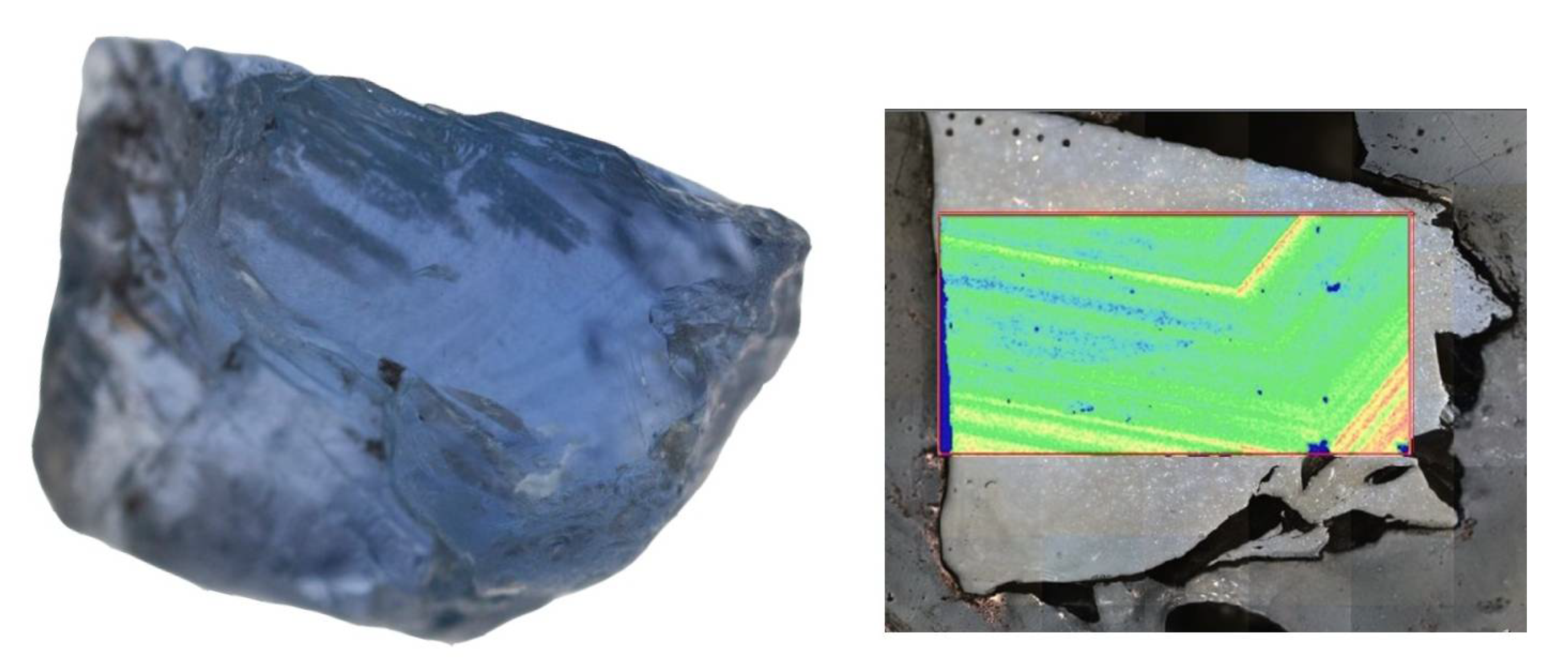
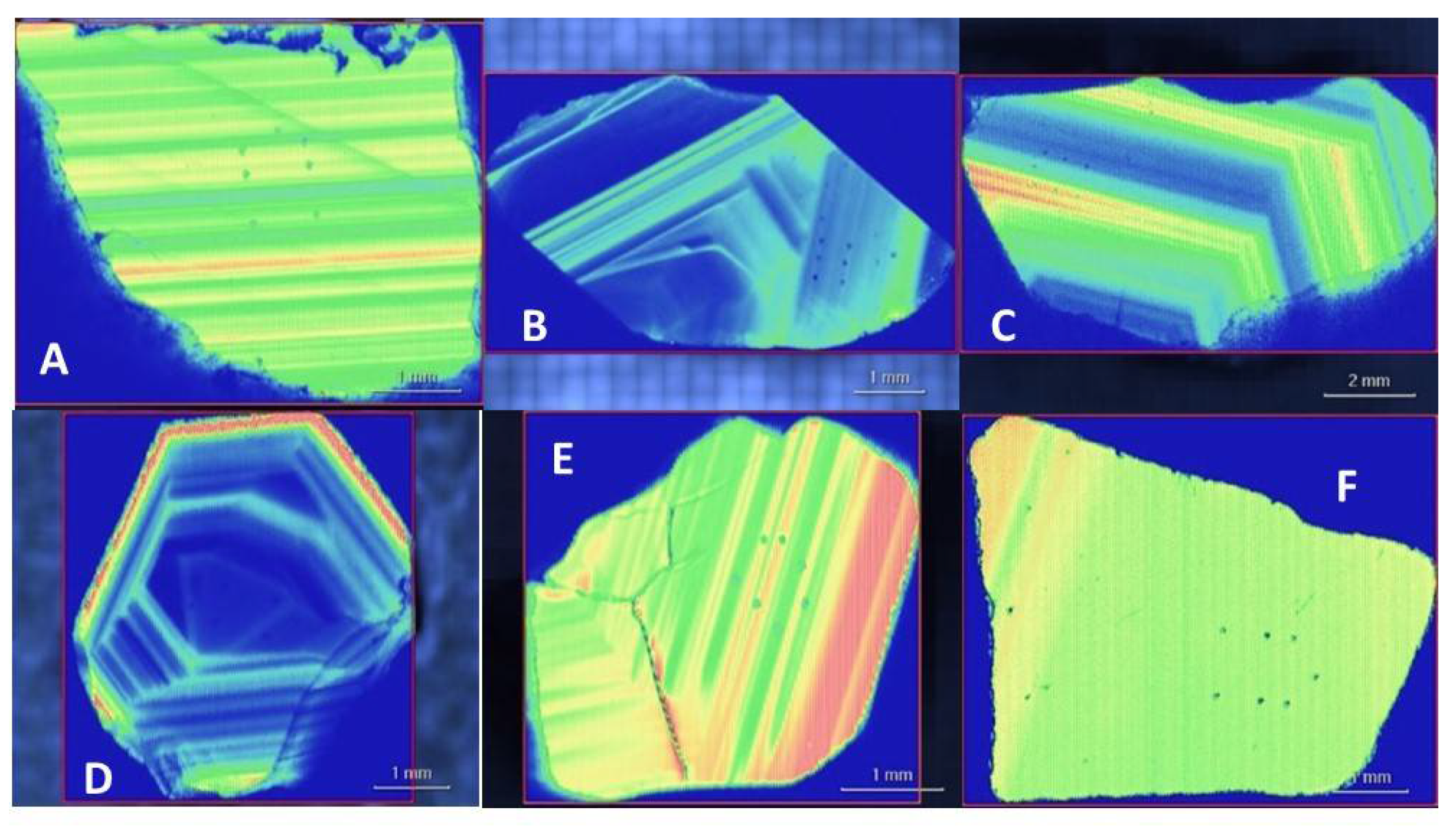
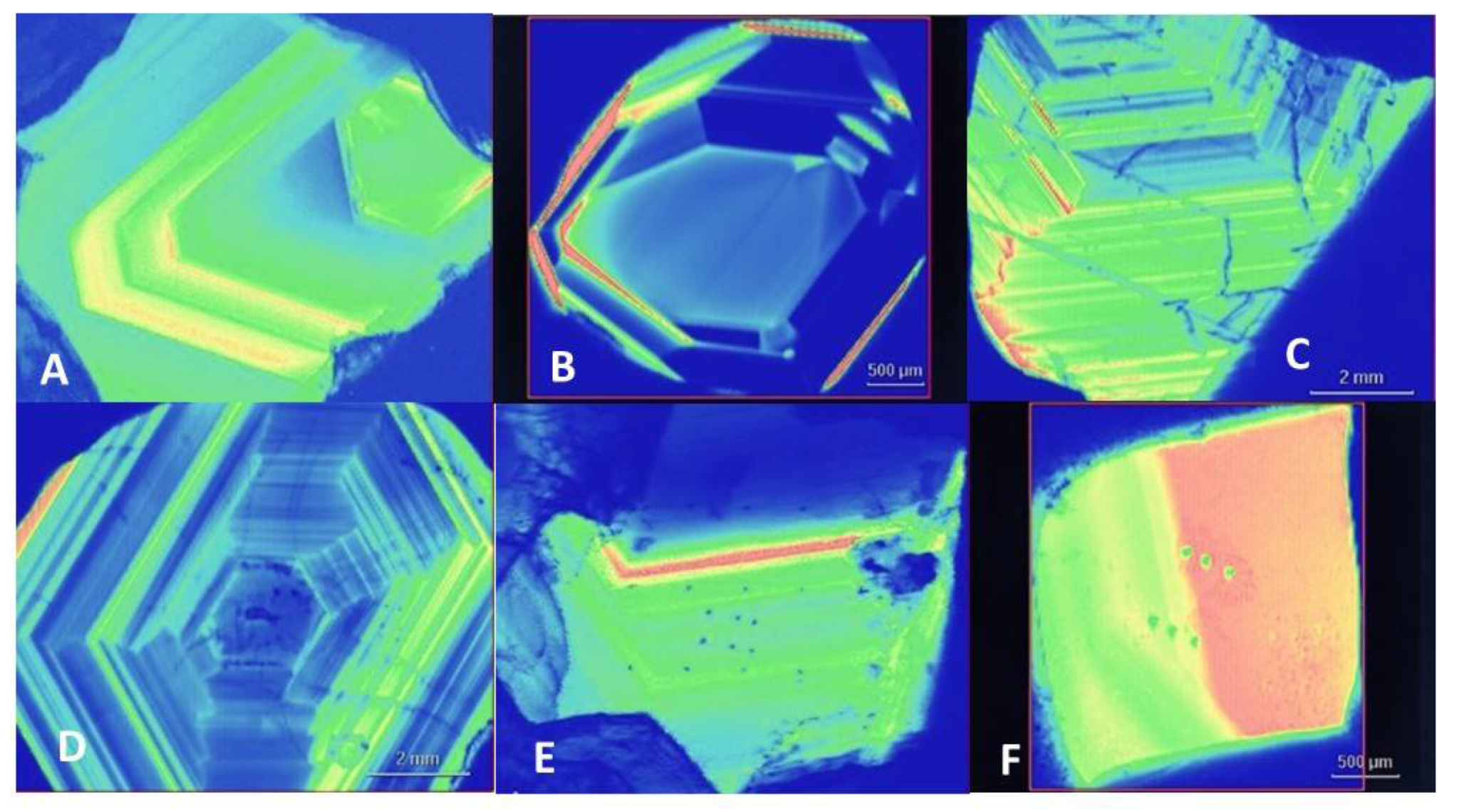
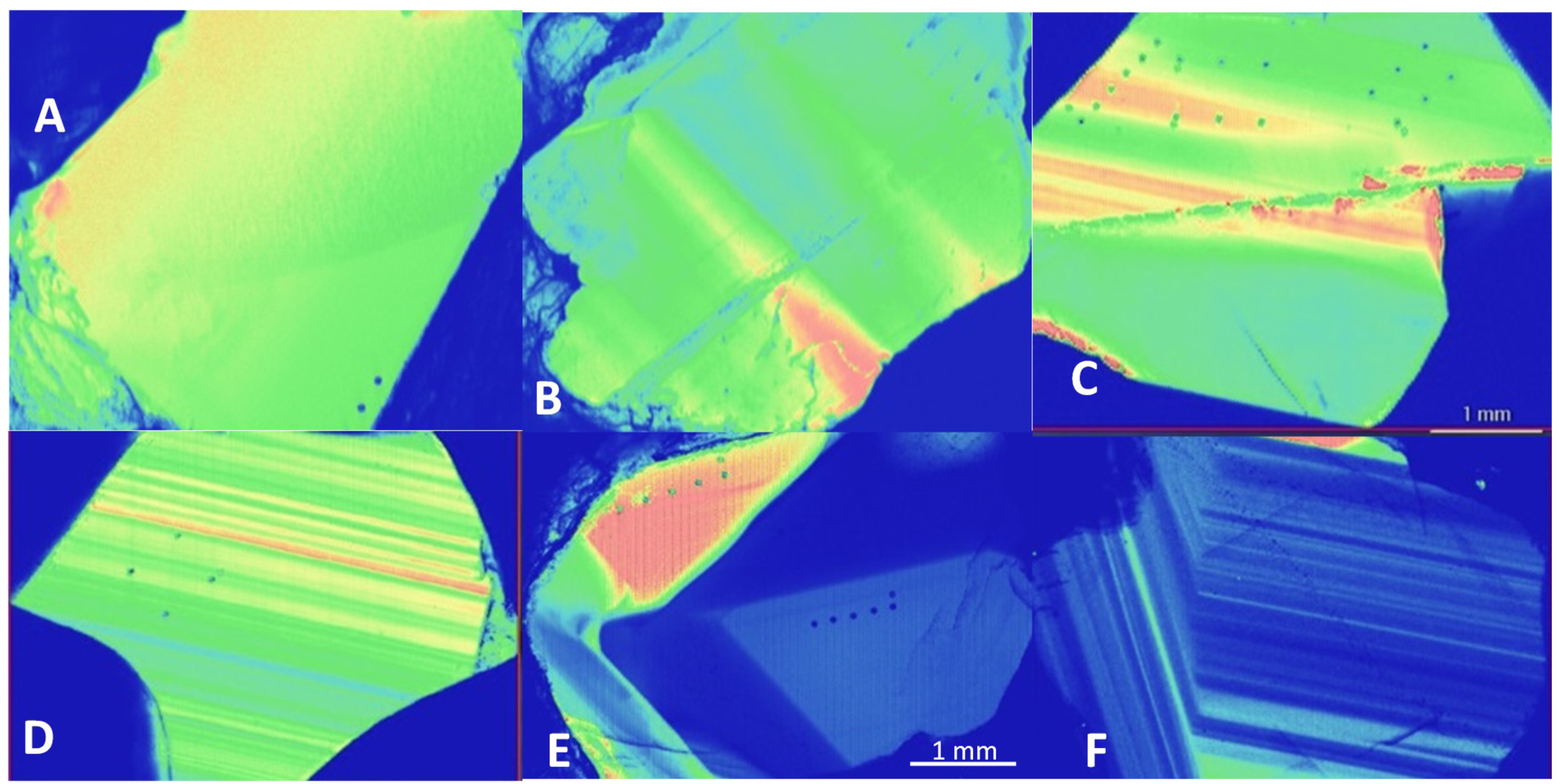
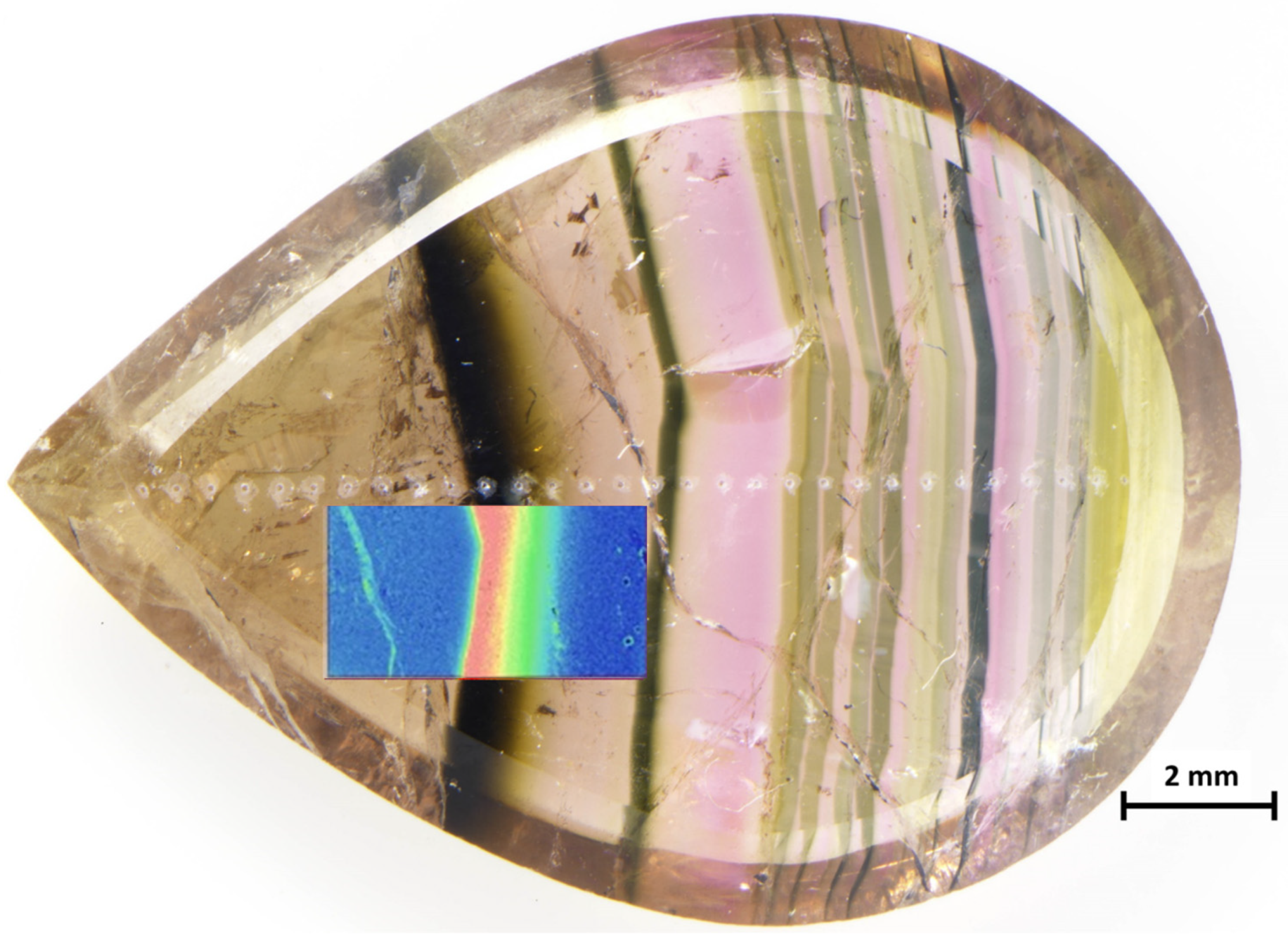
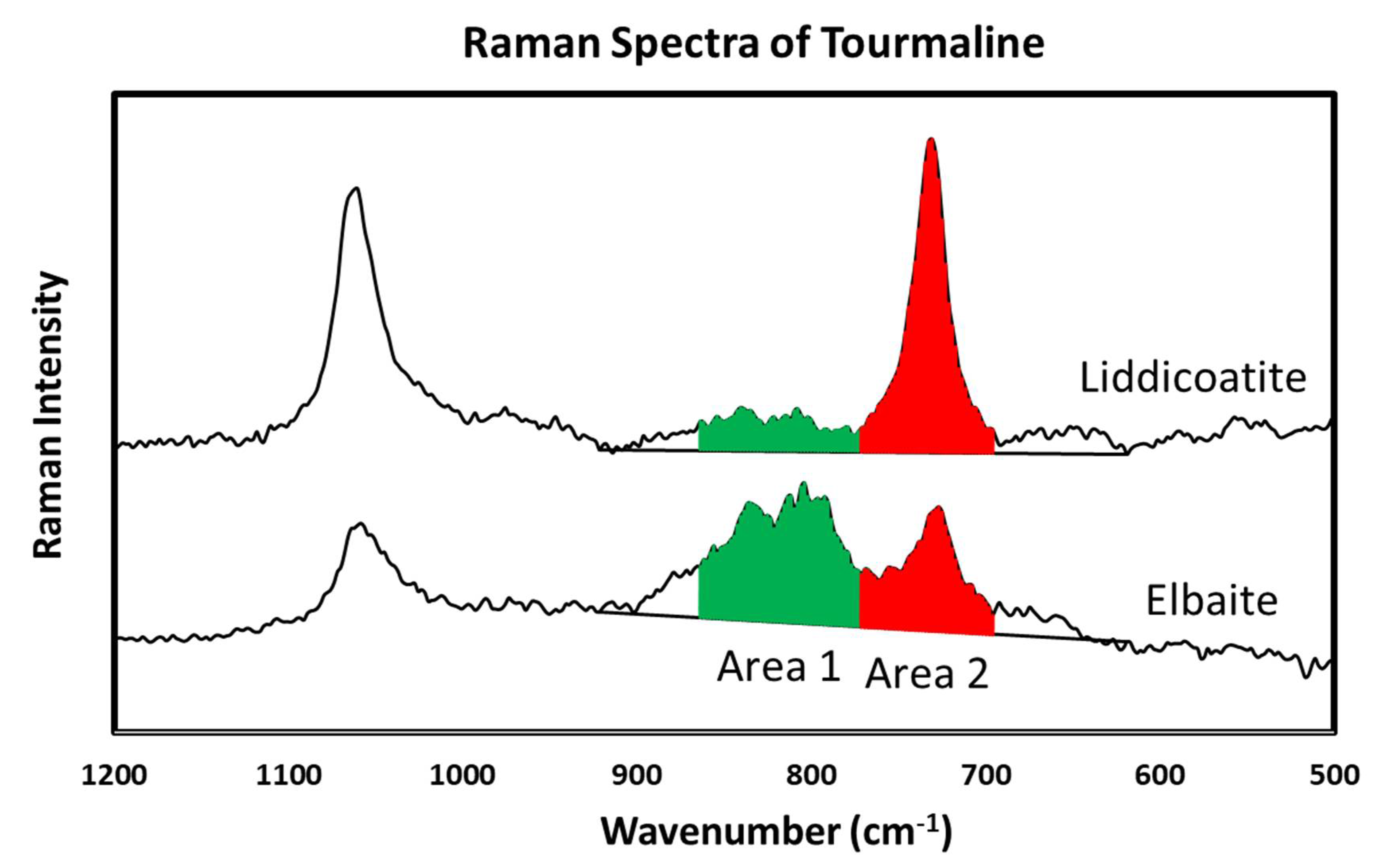
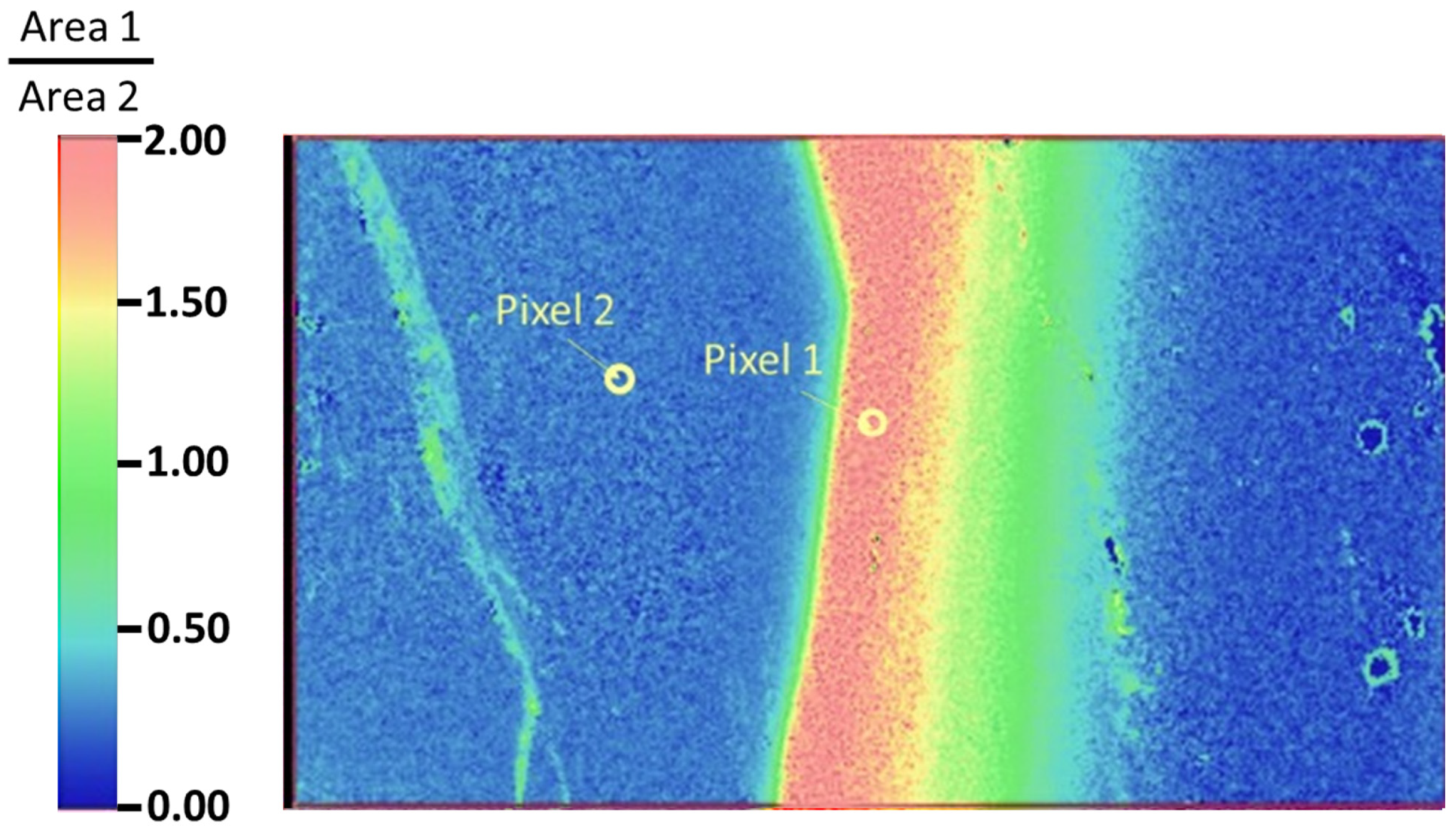
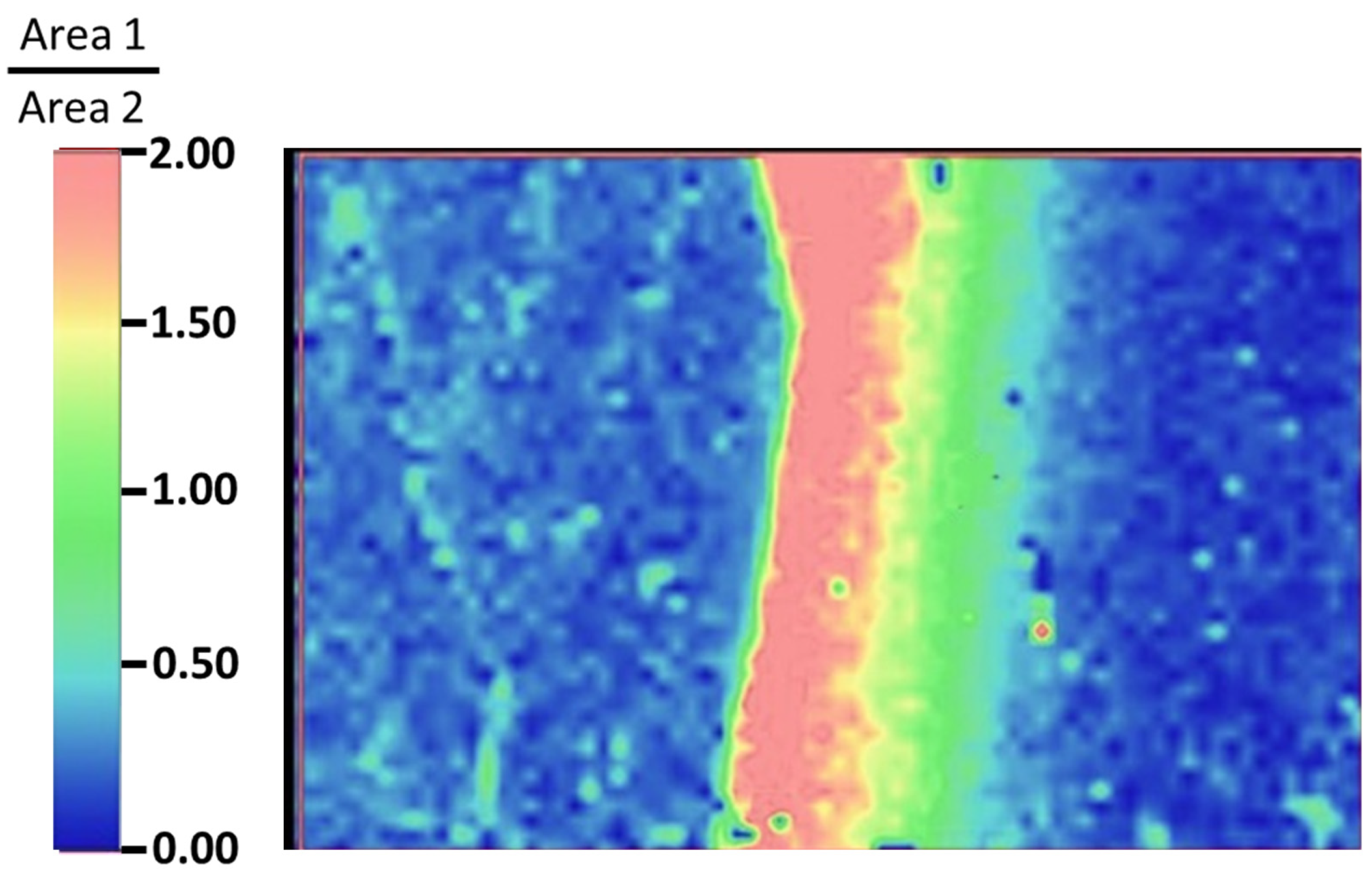
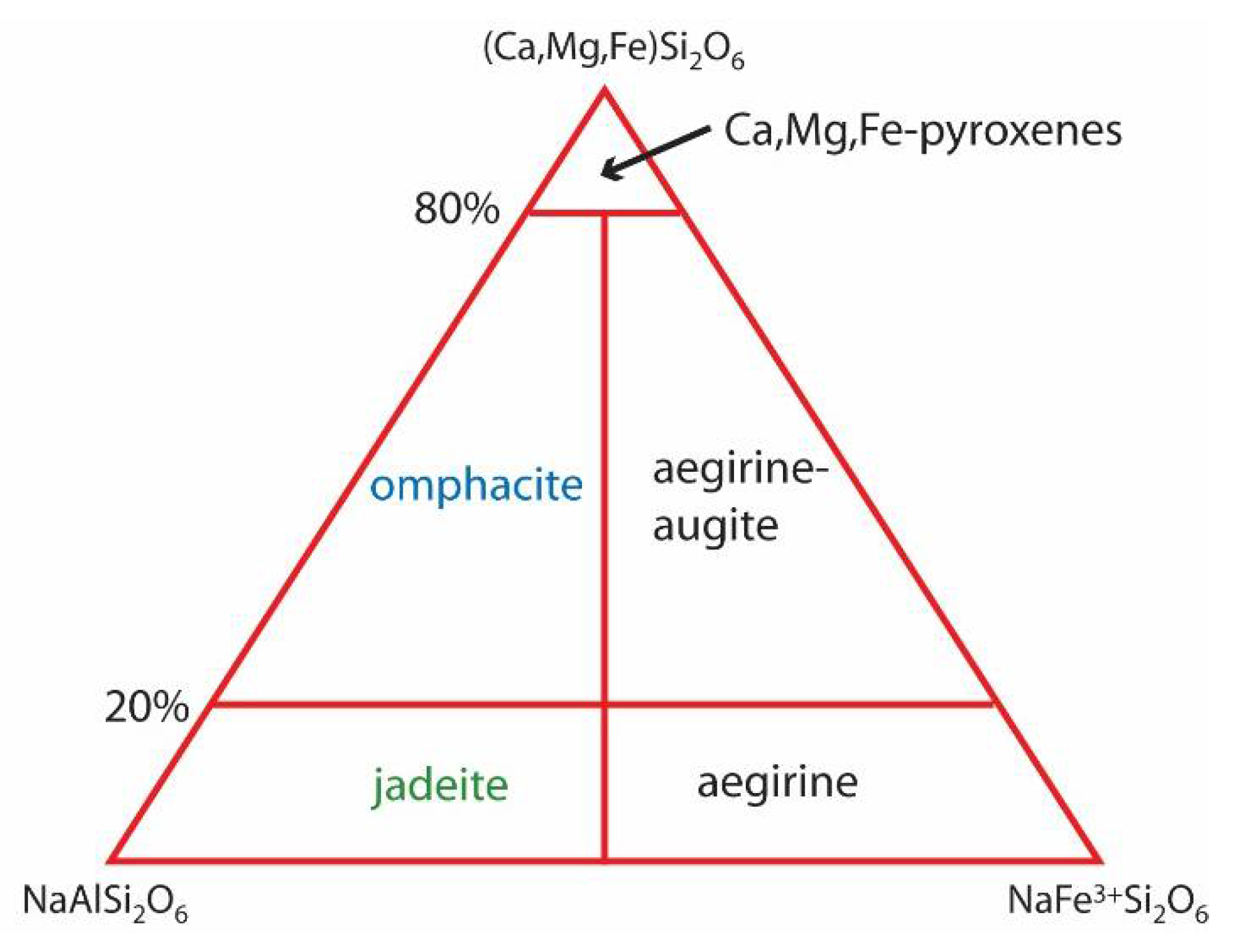
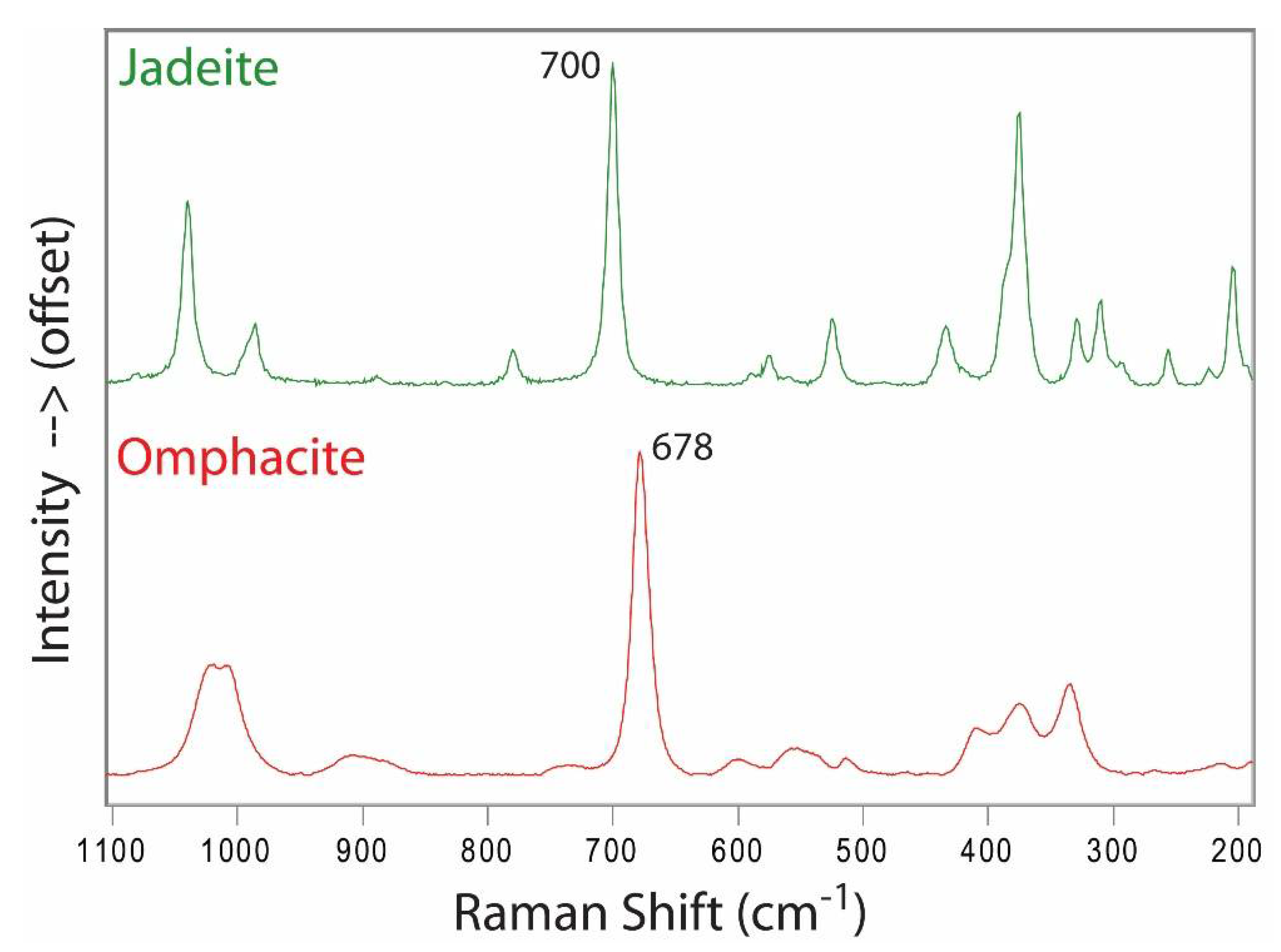

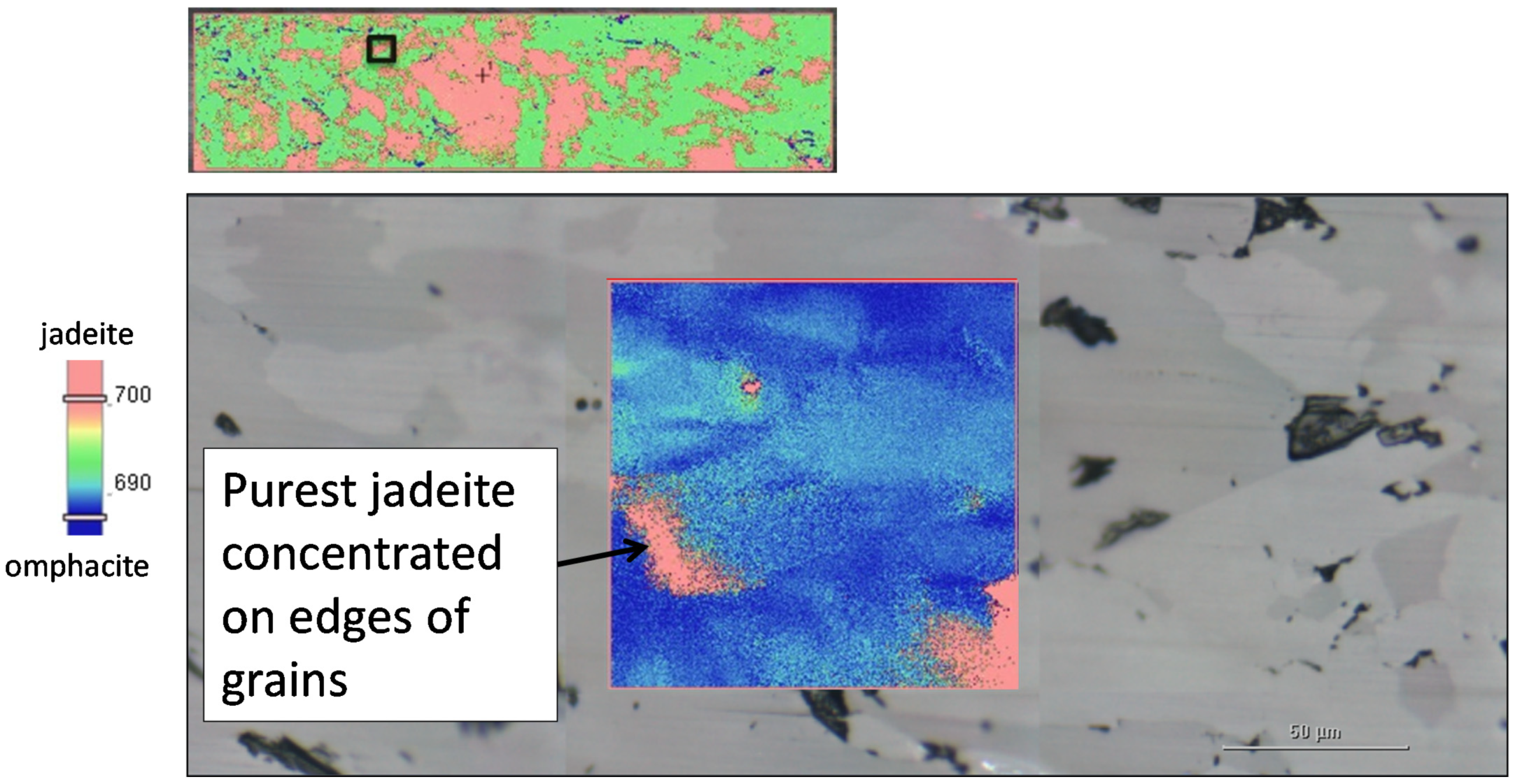

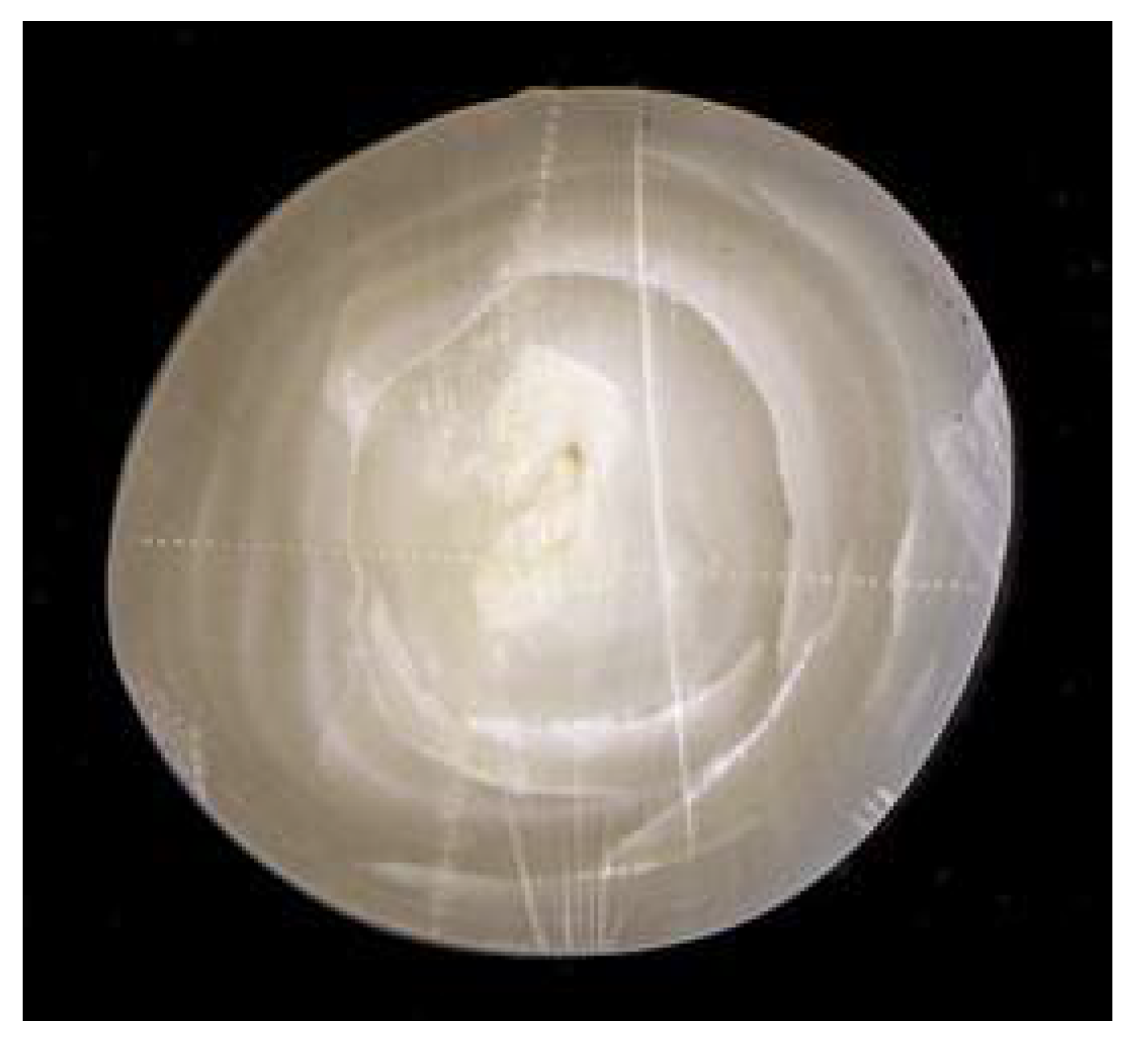

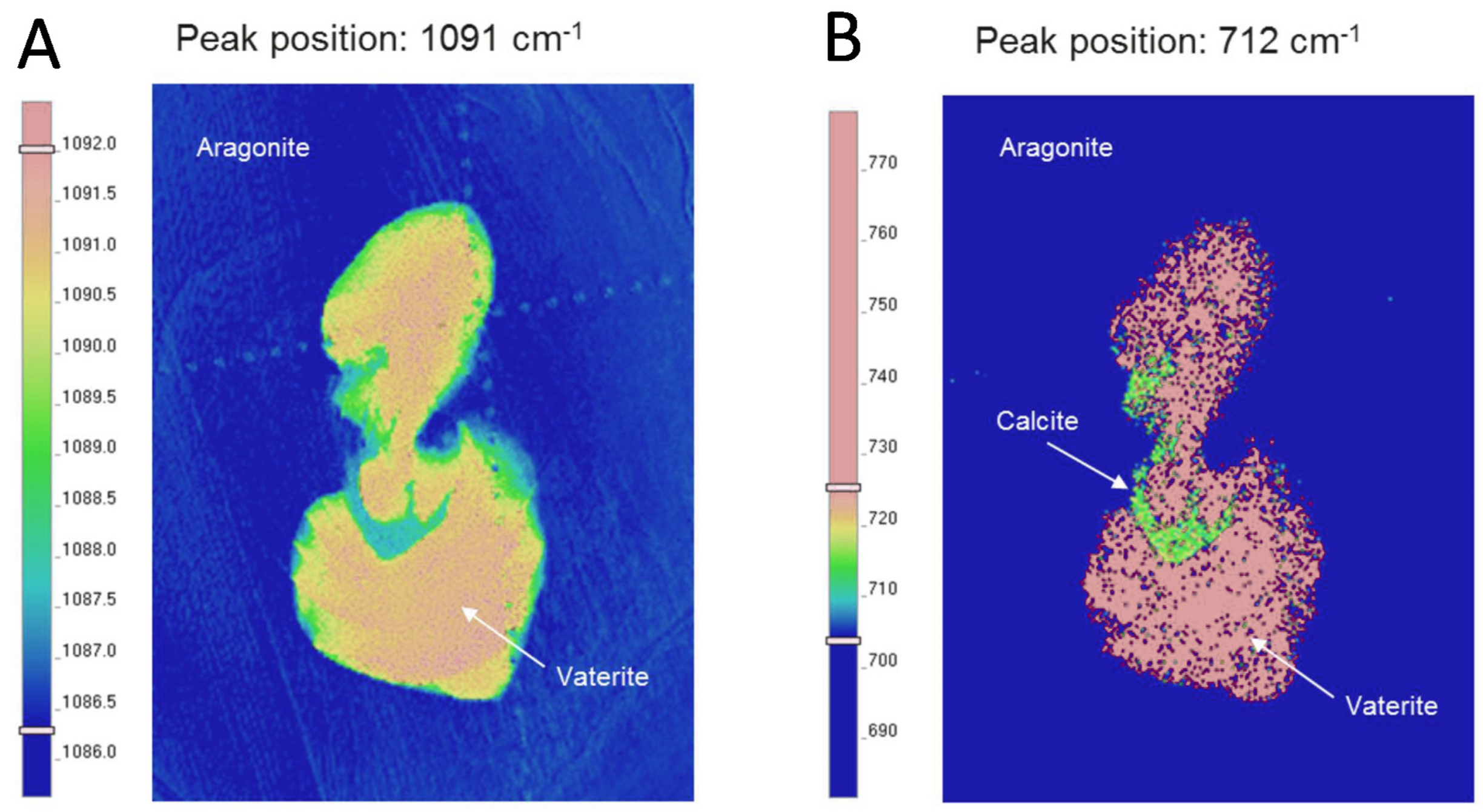
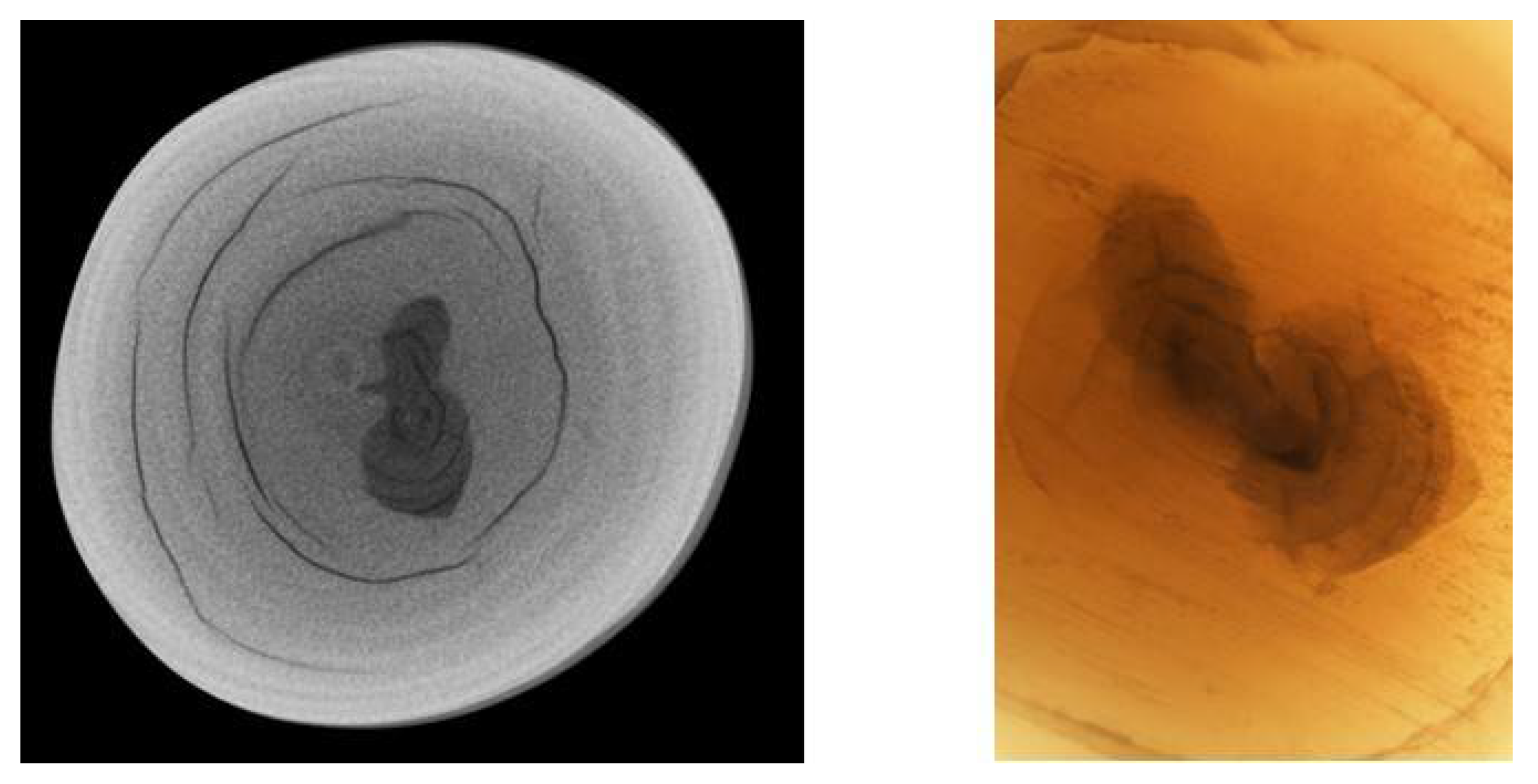
Publisher’s Note: MDPI stays neutral with regard to jurisdictional claims in published maps and institutional affiliations. |
© 2021 by the authors. Licensee MDPI, Basel, Switzerland. This article is an open access article distributed under the terms and conditions of the Creative Commons Attribution (CC BY) license (http://creativecommons.org/licenses/by/4.0/).
Share and Cite
Eaton-Magaña, S.; Breeding, C.M.; Palke, A.C.; Homkrajae, A.; Sun, Z.; McElhenny, G. Raman and Photoluminescence Mapping of Gem Materials. Minerals 2021, 11, 177. https://doi.org/10.3390/min11020177
Eaton-Magaña S, Breeding CM, Palke AC, Homkrajae A, Sun Z, McElhenny G. Raman and Photoluminescence Mapping of Gem Materials. Minerals. 2021; 11(2):177. https://doi.org/10.3390/min11020177
Chicago/Turabian StyleEaton-Magaña, Sally, Christopher M. Breeding, Aaron C. Palke, Artitaya Homkrajae, Ziyin Sun, and Garrett McElhenny. 2021. "Raman and Photoluminescence Mapping of Gem Materials" Minerals 11, no. 2: 177. https://doi.org/10.3390/min11020177
APA StyleEaton-Magaña, S., Breeding, C. M., Palke, A. C., Homkrajae, A., Sun, Z., & McElhenny, G. (2021). Raman and Photoluminescence Mapping of Gem Materials. Minerals, 11(2), 177. https://doi.org/10.3390/min11020177




